U.S. Department of Transportation
Federal Highway Administration
1200 New Jersey Avenue, SE
Washington, DC 20590
202-366-4000
Federal Highway Administration Research and Technology
Coordinating, Developing, and Delivering Highway Transportation Innovations
| REPORT |
| This report is an archived publication and may contain dated technical, contact, and link information |
|
| Publication Number: FHWA-HRT-14-070 Date: September 2014 |
Publication Number: FHWA-HRT-14-070 Date: September 2014 |
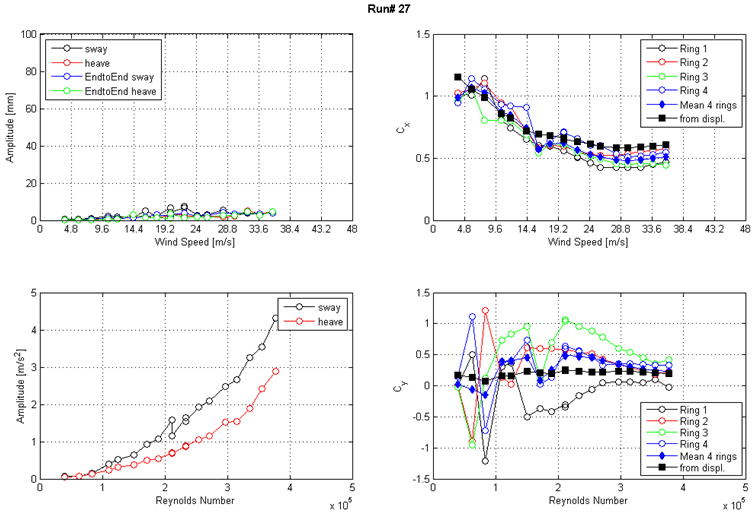 |
| Figure 59. Graph. Response of the cable as a function of wind speed or Reynolds number as measured by the lasers, accelerometers, and surface pressures for run 27. |
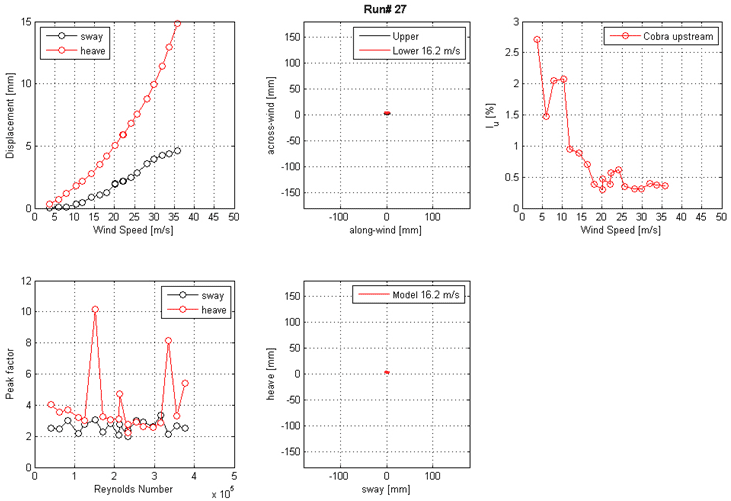 |
| Figure 60. Graph. Mean displacement and peak factor from the laser, motion path at one wind speed, and intensity of turbulence measured at the entrance of the test section for run 27. |
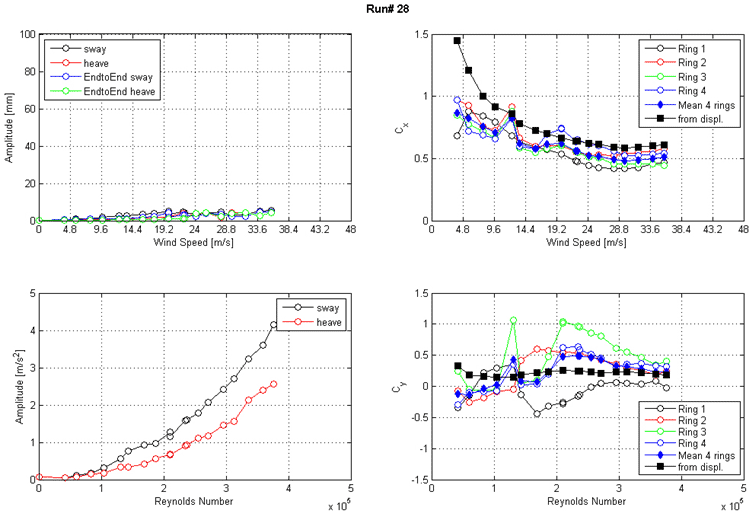 |
| Figure 61. Graph. Response of the cable as a function of wind speed or Reynolds number as measured by the lasers, accelerometers, and surface pressures for run 28. |
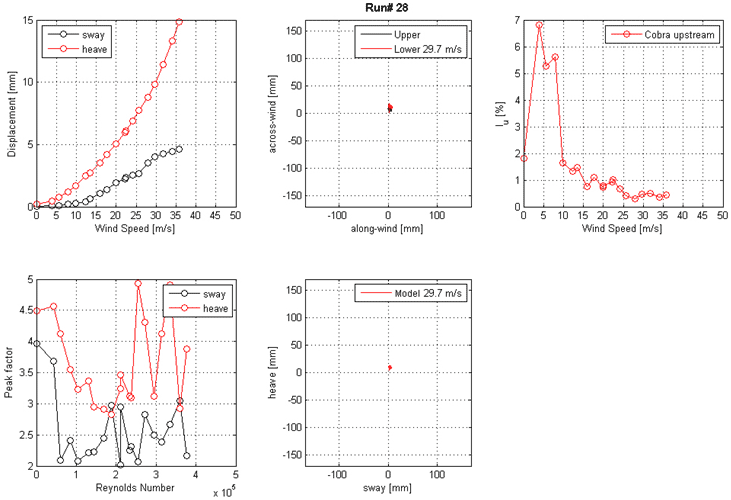 |
| Figure 62. Graph. Mean displacement and peak factor from the laser, motion path at one wind speed, and intensity of turbulence measured at the entrance of the test section for run 28. |
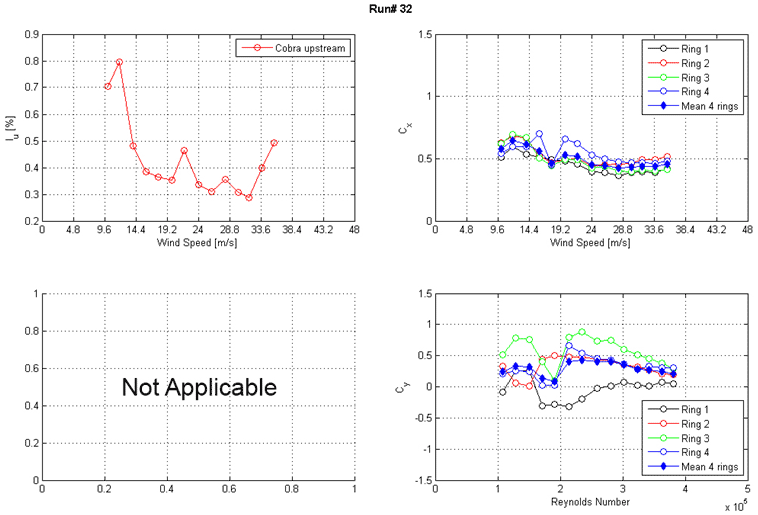 |
| Figure 63. Graph. Intensity of turbulence measured at the entrance of the test section and Cx and Cy calculated from surface pressure measurements as a function of Reynolds number and wind speed for run 32. |
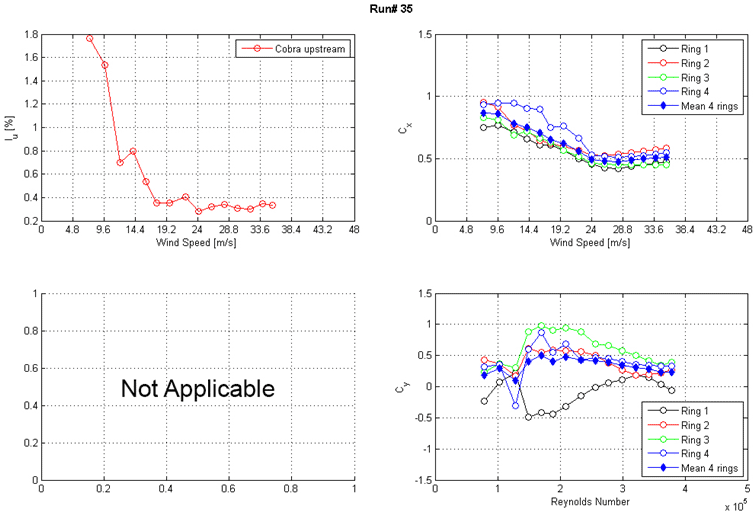 |
| Figure 64. Graph. Intensity of turbulence measured at the entrance of the test section and Cx and Cy calculated from surface pressure measurements as a function of Reynolds number and wind speed for run 35. |
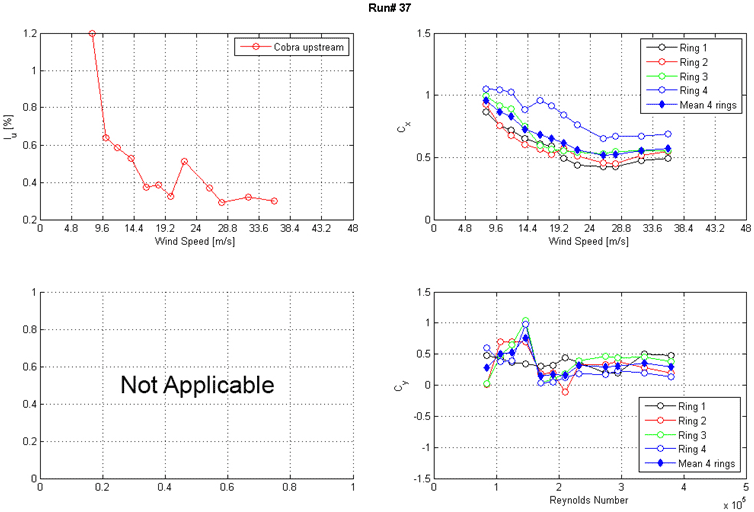 |
| Figure 65. Graph. Intensity of turbulence measured at the entrance of the test section and Cx and Cy calculated from surface pressure measurements as a function of Reynolds number and wind speed for run 37. |
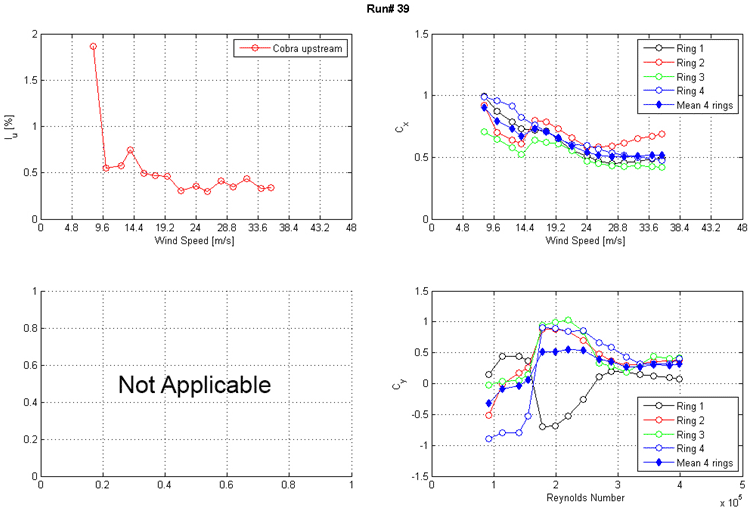 |
| Figure 66. Graph. Intensity of turbulence measured at the entrance of the test section and Cx and Cy calculated from surface pressure measurements as a function of Reynolds number and wind speed for run 39. |
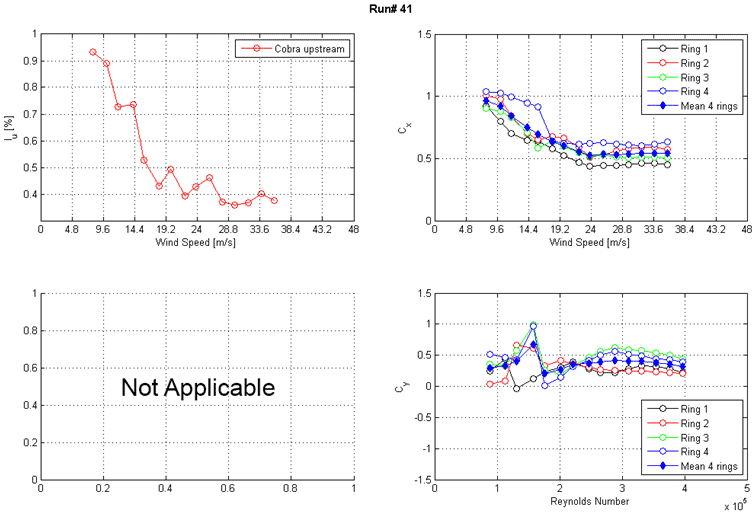 |
| Figure 67. Graph. Intensity of turbulence measured at the entrance of the test section and Cx and Cy calculated from surface pressure measurements as a function of Reynolds number and wind speed for run 41. |
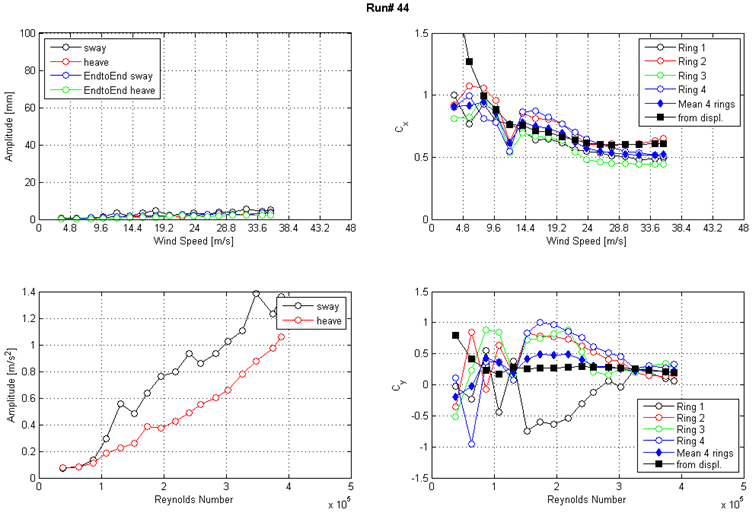 |
| Figure 68. Graph. Response of the cable as a function of wind speed or Reynolds number as measured by the lasers, accelerometers, and surface pressures for run 44. |
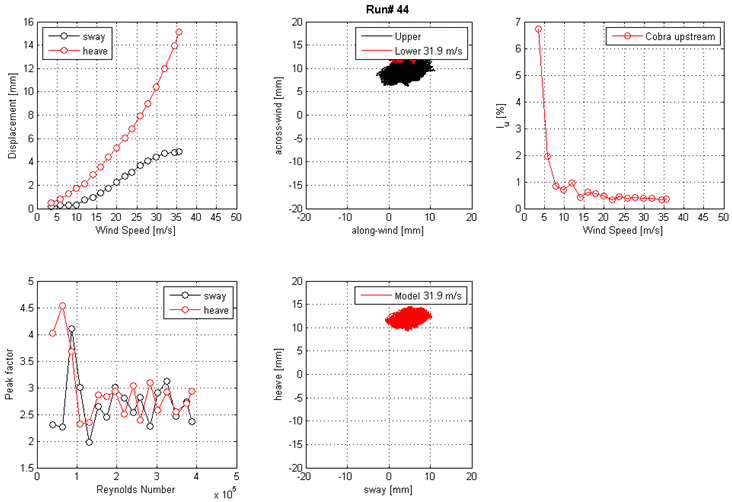 |
| Figure 69. Graph. Mean displacement and peak factor from the laser, motion path at one wind speed, and intensity of turbulence measured at the entrance of the test section for run 44. |
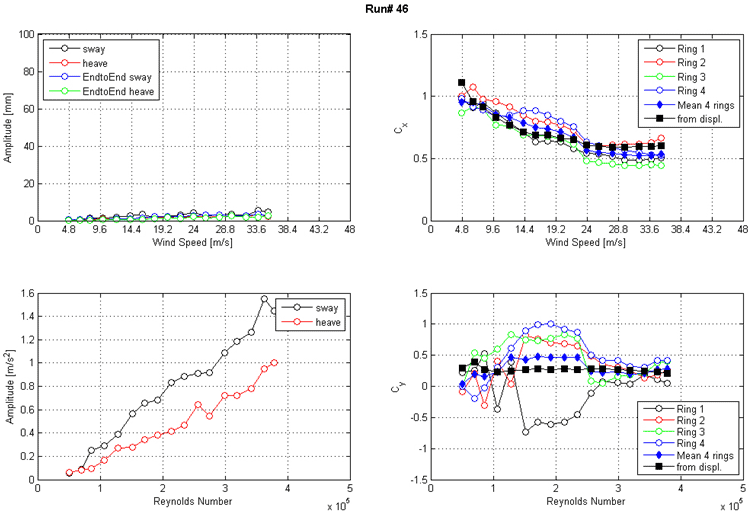 |
| Figure 70. Graph. Response of the cable as a function of wind speed or Reynolds number as measured by the lasers, accelerometers, and surface pressures for run 46. |
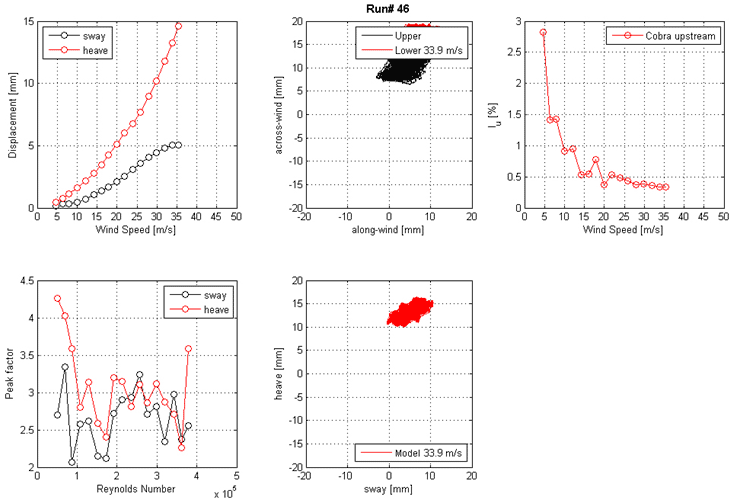 |
| Figure 71. Graph. Mean displacement and peak factor from the laser, motion path at one wind speed, and intensity of turbulence measured at the entrance of the test section for run 46. |
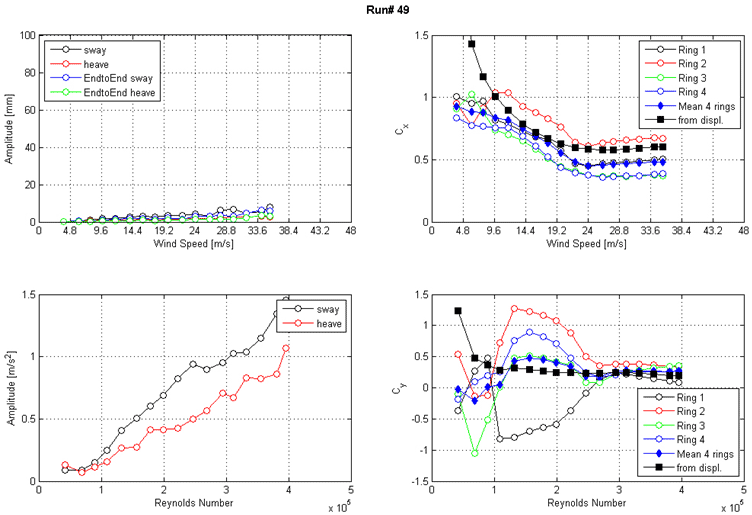 |
| Figure 72. Graph. Response of the cable as a function of wind speed or Reynolds number as measured by the lasers, accelerometers, and surface pressures for run 49. |
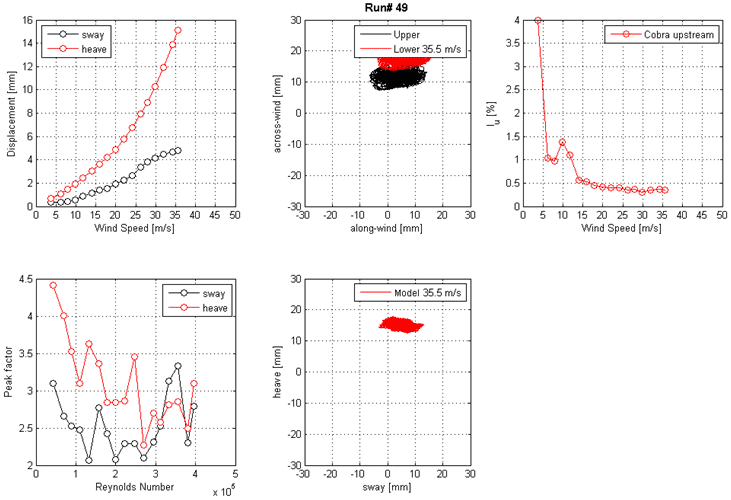 |
| Figure 73. Graph. Mean displacement and peak factor from the laser, motion path at one wind speed, and intensity of turbulence measured at the entrance of the test section for run 49. |
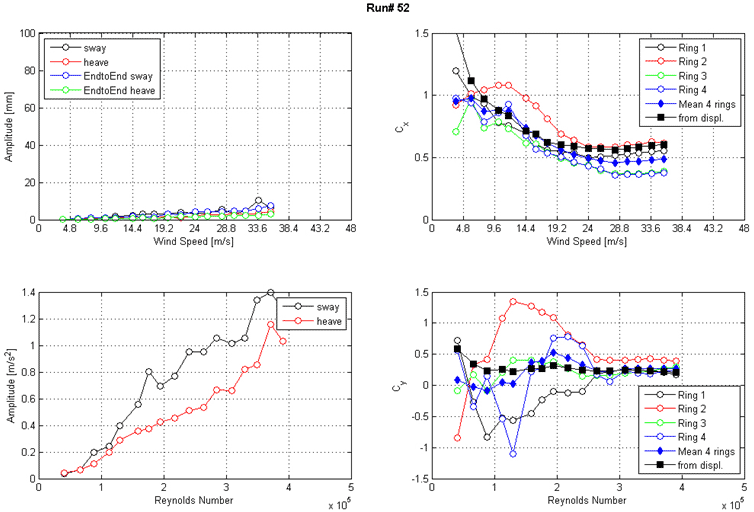 |
| Figure 74. Graph. Response of the cable as a function of wind speed or Reynolds number as measured by the lasers, accelerometers, and surface pressures for run 52. |
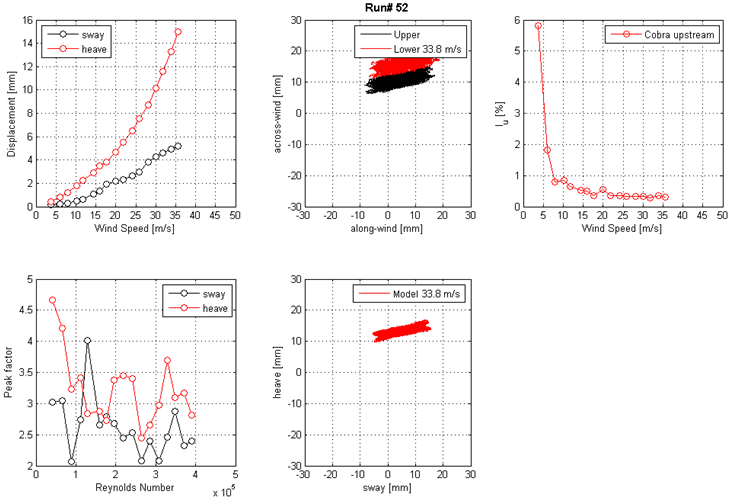 |
| Figure 75. Graph. Mean displacement and peak factor from the laser, motion path at one wind speed, and intensity of turbulence measured at the entrance of the test section for run 52. |
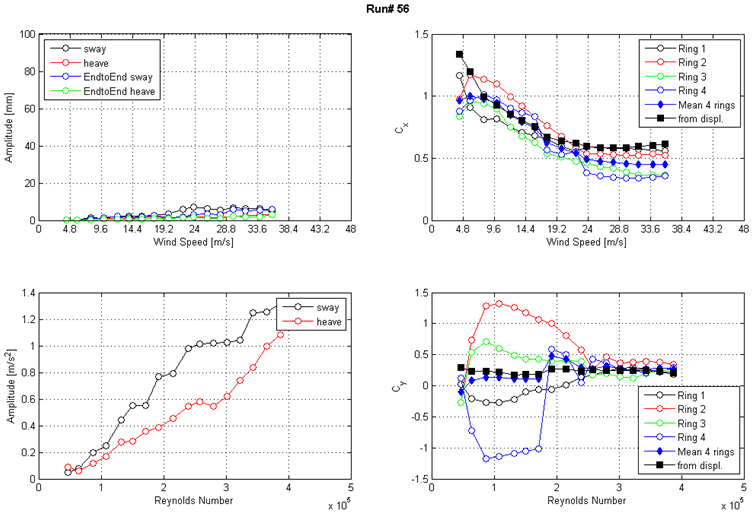 |
| Figure 76. Graph. Response of the cable as a function of wind speed or Reynolds number as measured by the lasers, accelerometers, and surface pressures for run 56. |
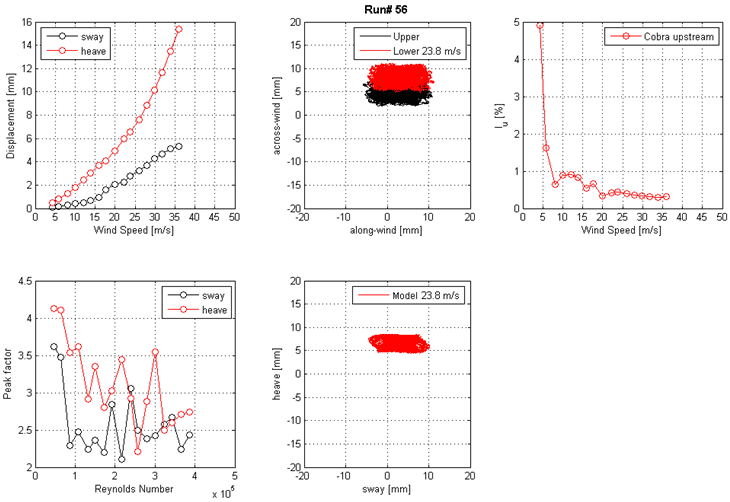 |
| Figure 77. Graph. Mean displacement and peak factor from the laser, motion path at one wind speed, and intensity of turbulence measured at the entrance of the test section for run 56. |
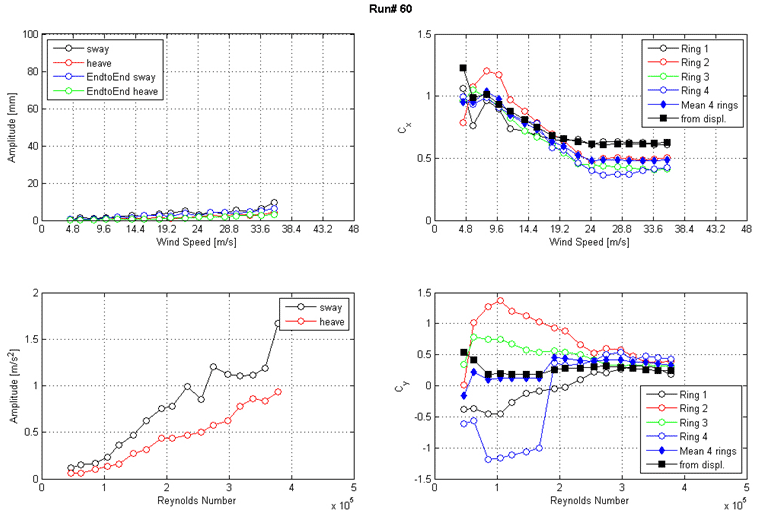 |
| Figure 78. Graph. Response of the cable as a function of wind speed or Reynolds number as measured by the lasers, accelerometers, and surface pressures for run 60. |
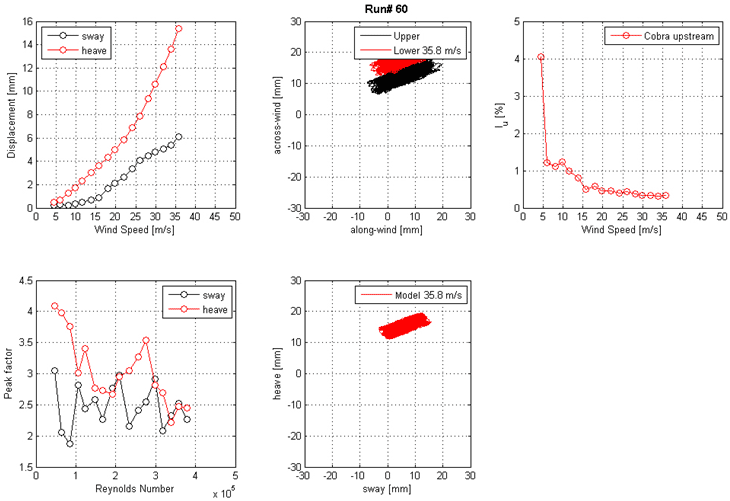 |
| Figure 79. Graph. Mean displacement and peak factor from the laser, motion path at one wind speed, and intensity of turbulence measured at the entrance of the test section for run 60. |
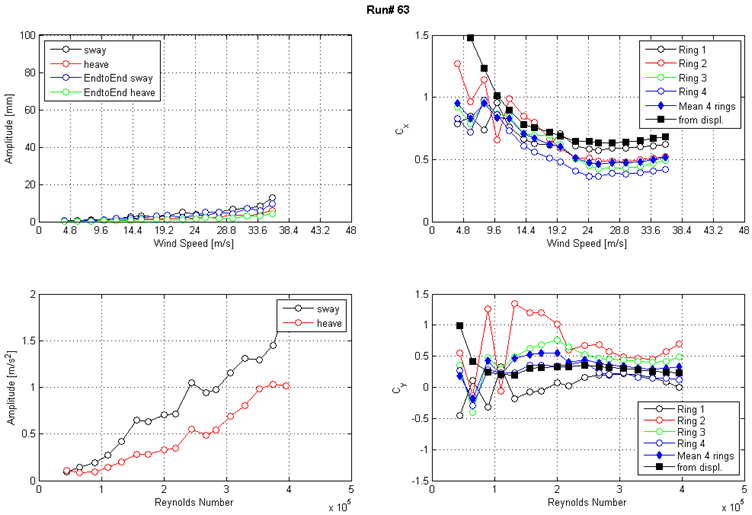 |
| Figure 80. Graph. Response of the cable as a function of wind speed or Reynolds number as measured by the lasers, the accelerometers, and surface pressures for run 63. |
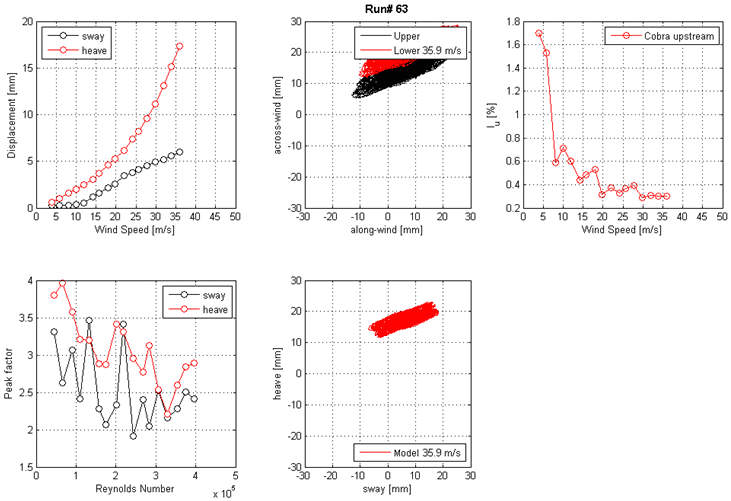 |
| Figure 81. Graph. Mean displacement and peak factor from the laser, motion path at one wind speed, and intensity of turbulence measured at the entrance of the test section for run 63. |
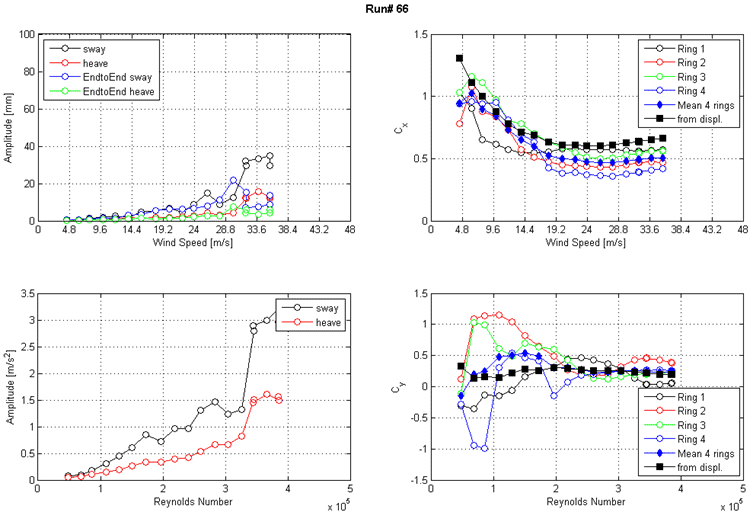 |
| Figure 82. Graph. Response of the cable as a function of wind speed or Reynolds number as measured by the lasers, the accelerometers, and surface pressures for run 66. |
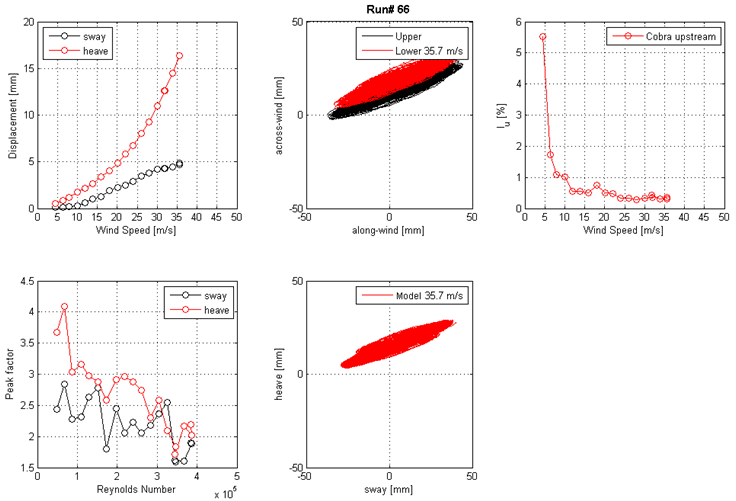 |
| Figure 83. Graph. Mean displacement and peak factor from the laser, motion path at one wind speed, and intensity of turbulence measured at the entrance of the test section for run 66. |
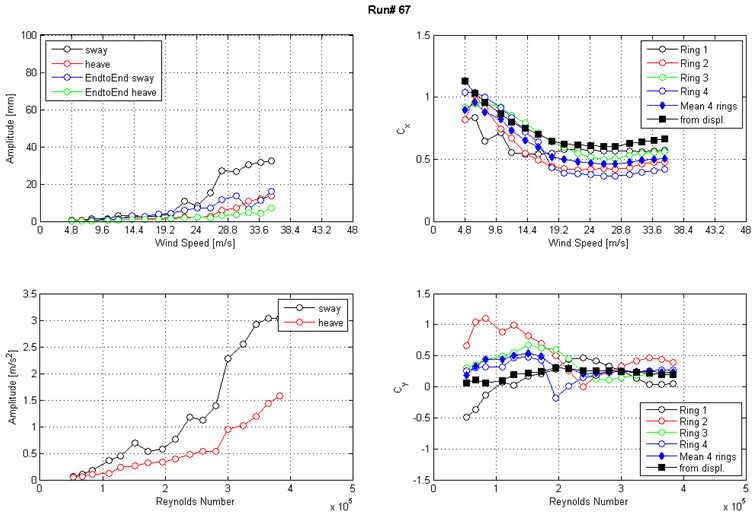 |
| Figure 84 Graph. Response of the cable as a function of wind speed or Reynolds number as measured by the lasers, the accelerometers, and surface pressures for run 67. |
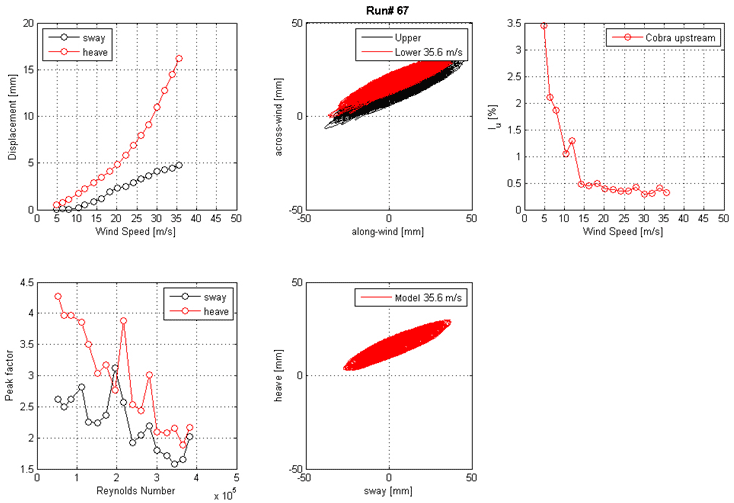 |
| Figure 85. Graph. Mean displacement and peak factor from the laser, motion path at one wind speed, and intensity of turbulence measured at the entrance of the test section for run 67. |
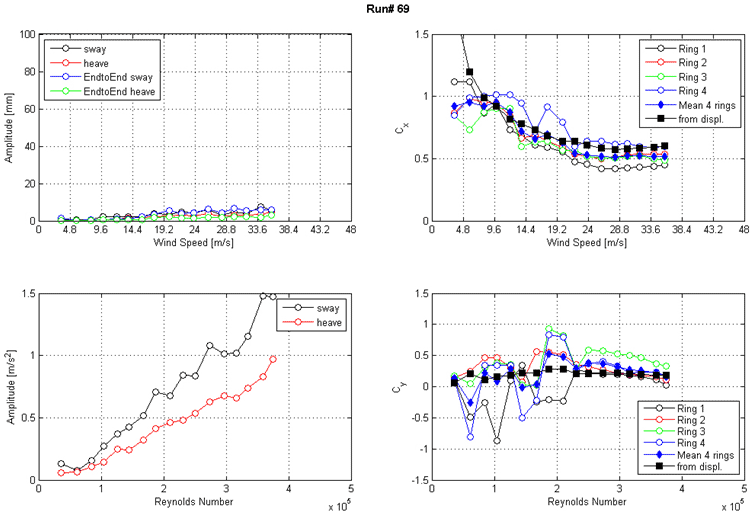 |
| Figure 86. Graph. Response of the cable as a function of wind speed or Reynolds number as measured by the lasers, accelerometers, and surface pressures for run 69. |
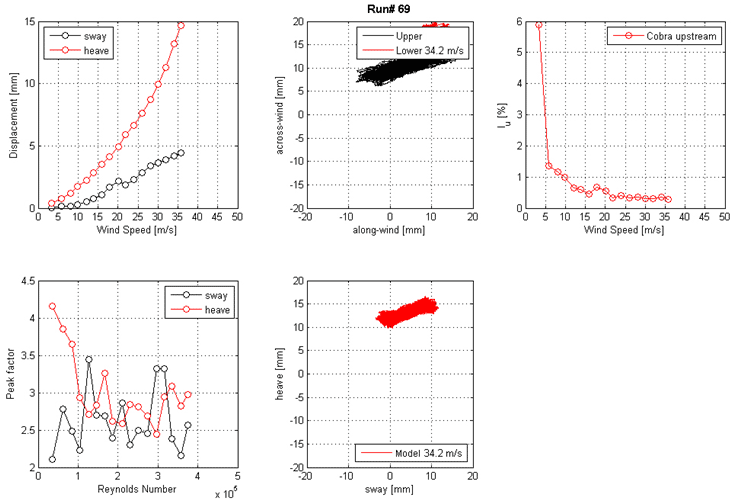 |
| Figure 87. Graph. Mean displacement and peak factor from the laser, motion path at one wind speed, and intensity of turbulence measured at the entrance of the test section for run 69. |
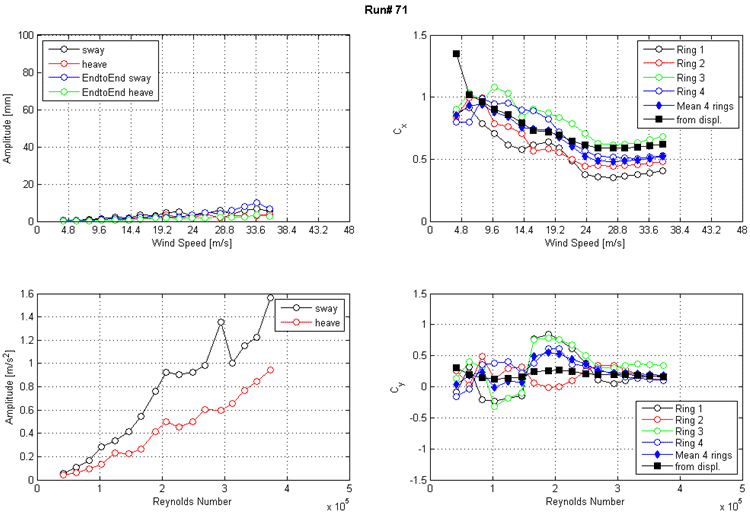 |
| Figure 88. Graph. Response of the cable as a function of wind speed or Reynolds number as measured by the lasers, the accelerometers, and surface pressures for run 71. |
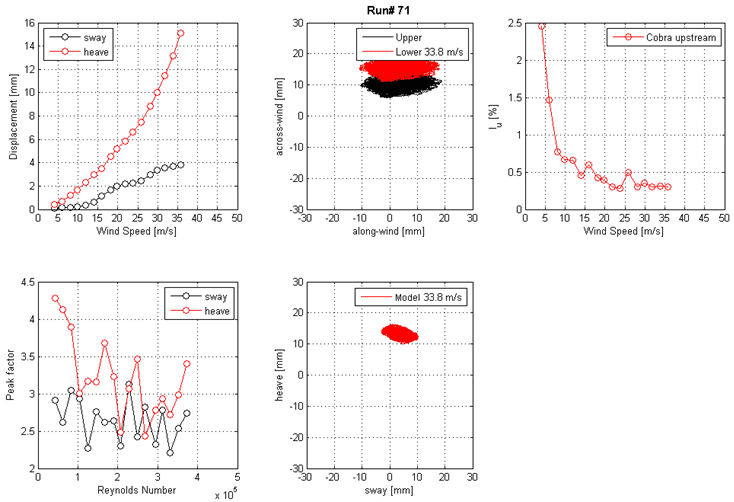 |
| Figure 89. Graph. Mean displacement and peak factor from the laser, motion path at one wind speed, and intensity of turbulence measured at the entrance of the test section for run 71. |
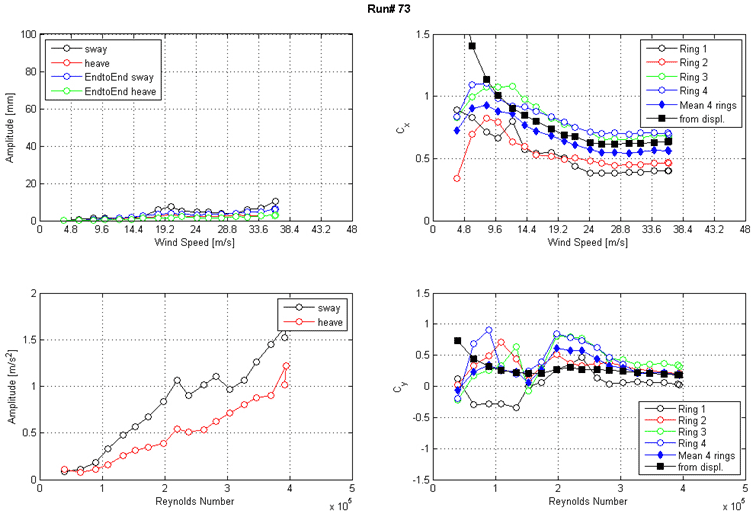 |
| Figure 90. Graph. Response of the cable as a function of wind speed or Reynolds number as measured by the lasers, the accelerometers, and surface pressures for run 73. |
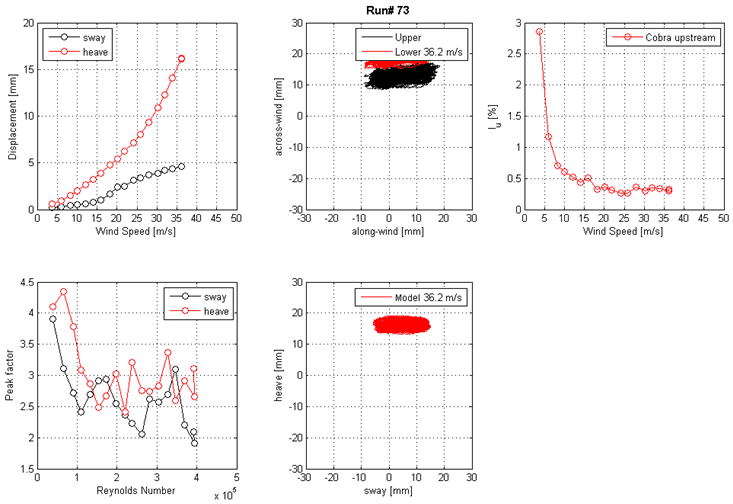 |
| Figure 91. Graph. Mean displacement and peak factor from the laser, motion path at one wind speed, and intensity of turbulence measured at the entrance of the test section for run 73. |
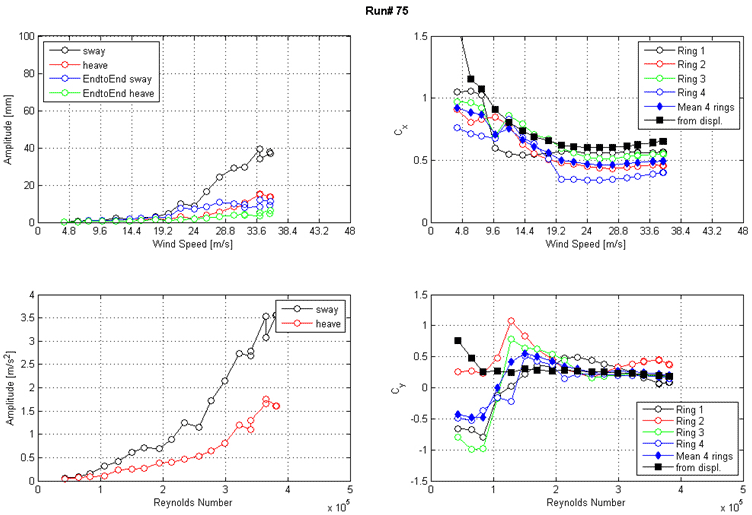 |
| Figure 92. Graph. Response of the cable as a function of wind speed or Reynolds number as measured by the lasers, the accelerometers, and surface pressures for run 75. |
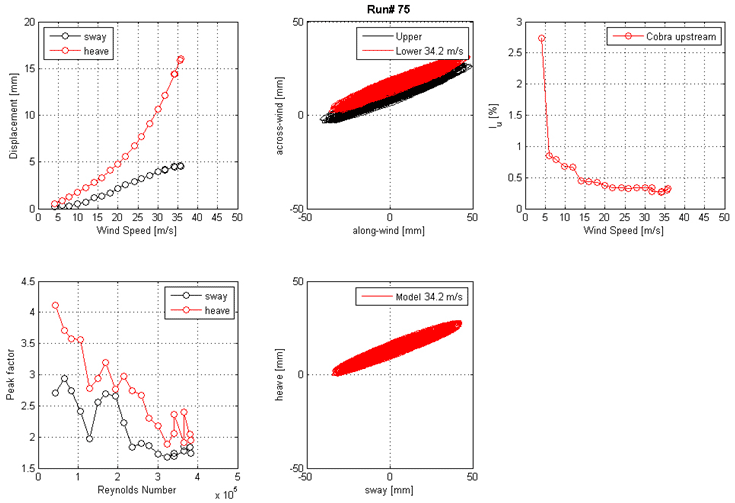 |
| Figure 93. Graph. Mean displacement and peak factor from the laser, motion path at one wind speed, and intensity of turbulence measured at the entrance of the test section for run 75. |
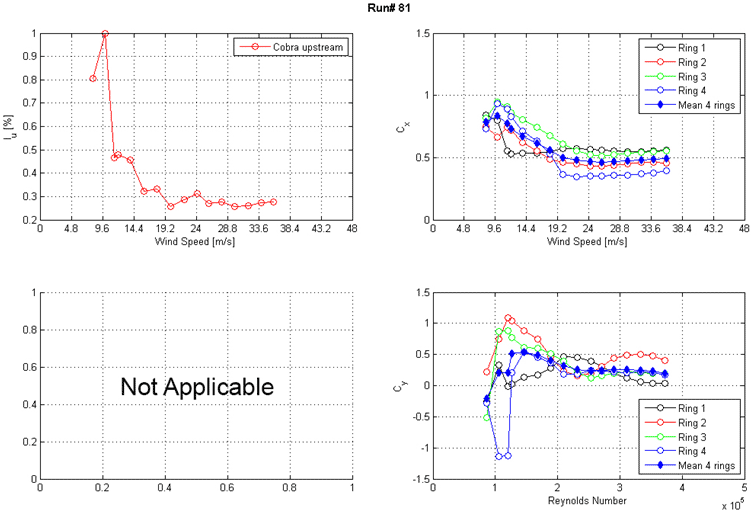 |
| Figure 94. Graph. Intensity of turbulence measured at the entrance of the test section and Cx and Cy calculated from surface pressure measurements as a function of Reynolds number and wind speed for run 81. |
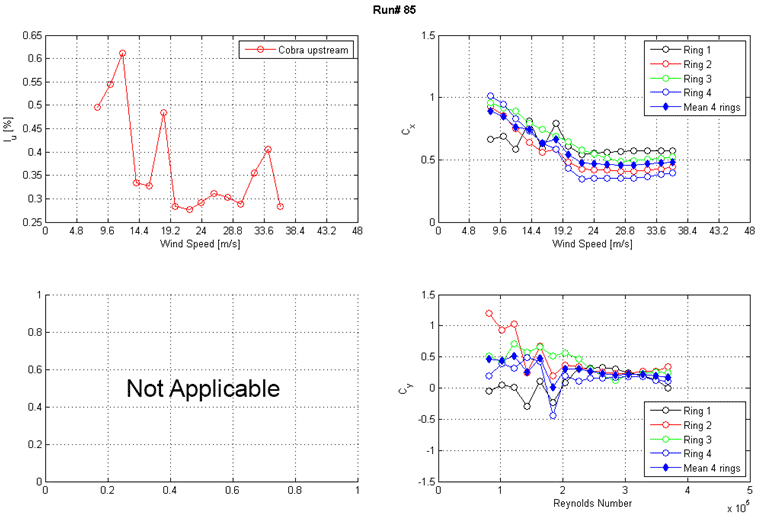 |
| Figure 95. Graph. Intensity of turbulence measured at the entrance of the test section and Cx and Cy calculated from surface pressure measurements as a function of Reynolds number and wind speed for run 85. |
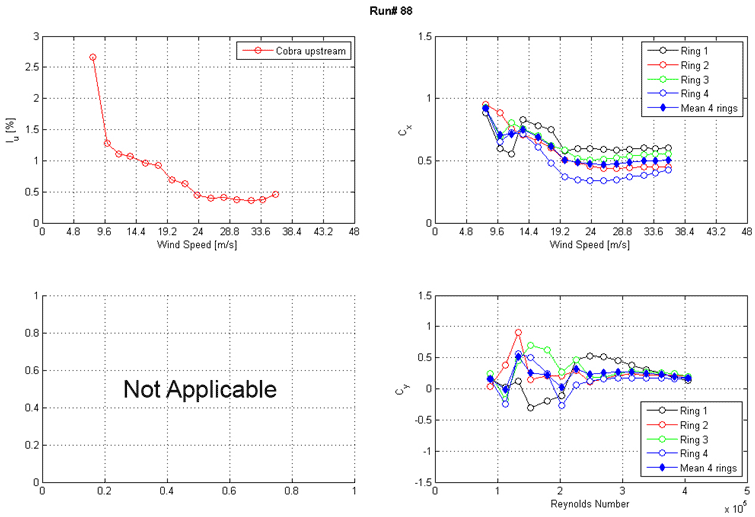 |
| Figure 96. Graph. Intensity of turbulence measured at the entrance of the test section and Cx and Cy calculated from surface pressure measurements as a function of Reynolds number and wind speed for run 88. |
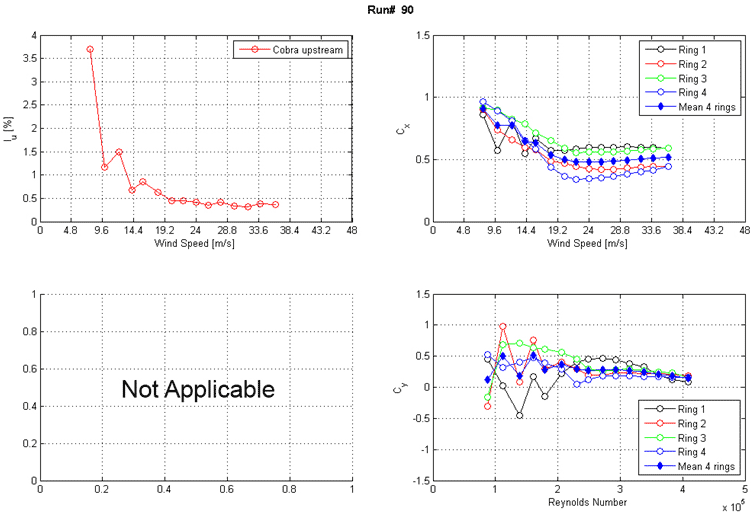 |
| Figure 97. Graph. Intensity of turbulence measured at the entrance of the test section and Cx and Cy calculated from surface pressure measurements as a function of Reynolds number and wind speed for run 90. |
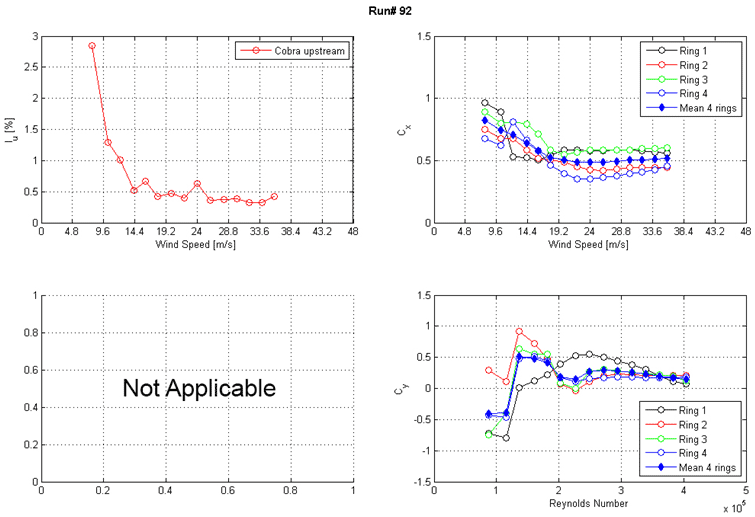 |
| Figure 98. Graph. Intensity of turbulence measured at the entrance of the test section and Cx and Cy calculated from surface pressure measurements as a function of Reynolds number and wind speed for run 92. |
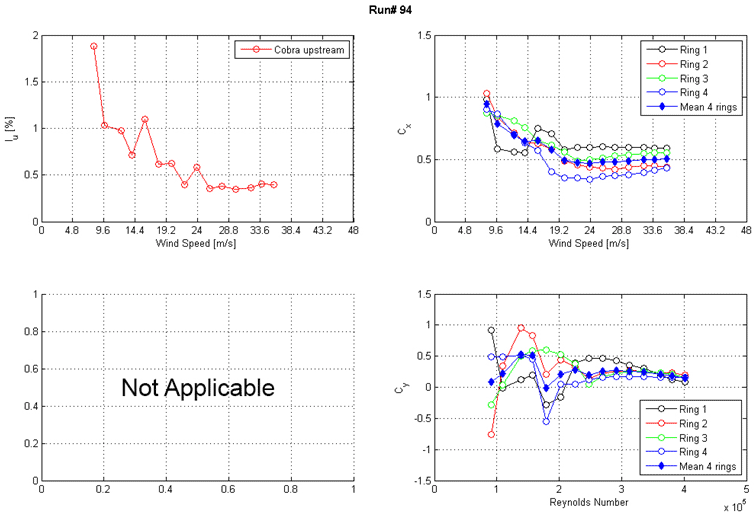 |
| Figure 99. Graph. Intensity of turbulence measured at the entrance of the test section and Cx and Cy calculated from surface pressure measurements as a function of Reynolds number and wind speed for run 94. |
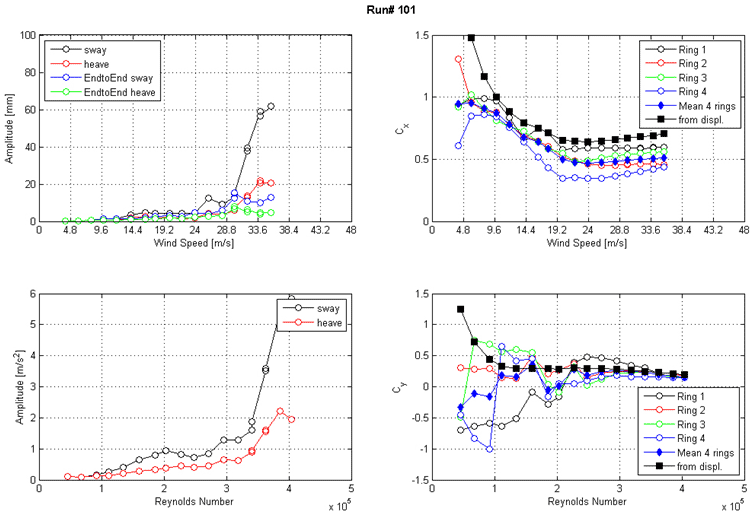 |
| Figure 100. Graph. Response of the cable as a function of wind speed or Reynolds number as measured by the lasers, accelerometers, and surface pressures for run 101. |
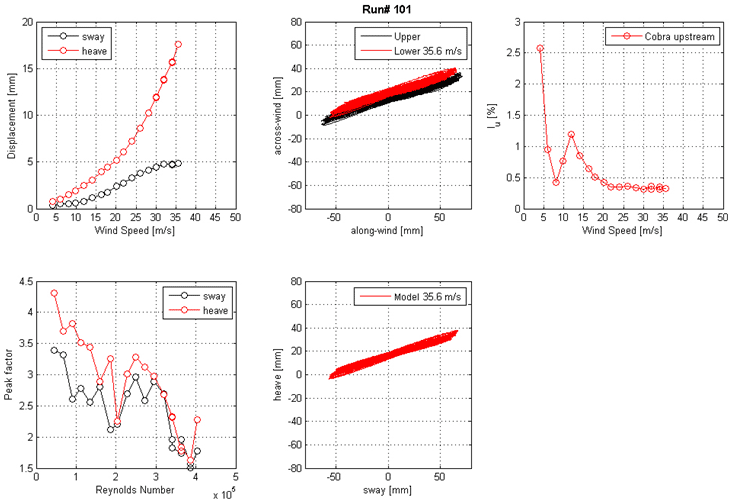 |
| Figure 101. Graph. Mean displacement and peak factor from the laser, motion path at one wind speed, and intensity of turbulence measured at the entrance of the test section for run 101. |
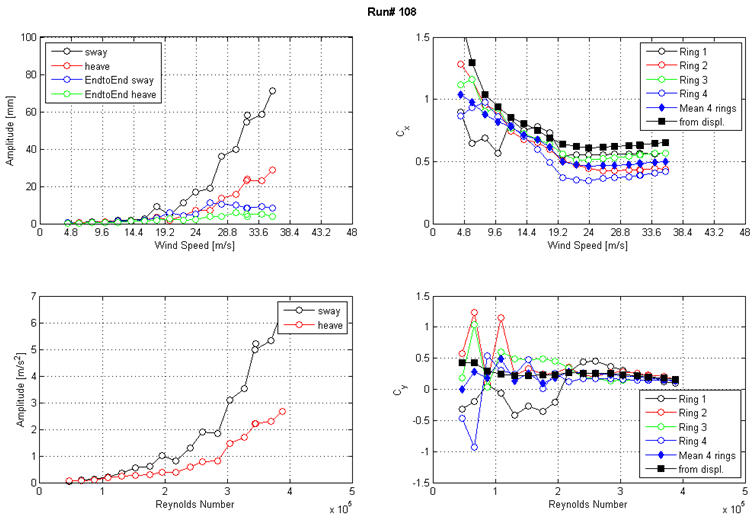 |
| Figure 102. Graph. Response of the cable as a function of wind speed or Reynolds number as measured by the lasers, accelerometers, and surface pressures for run 108. |
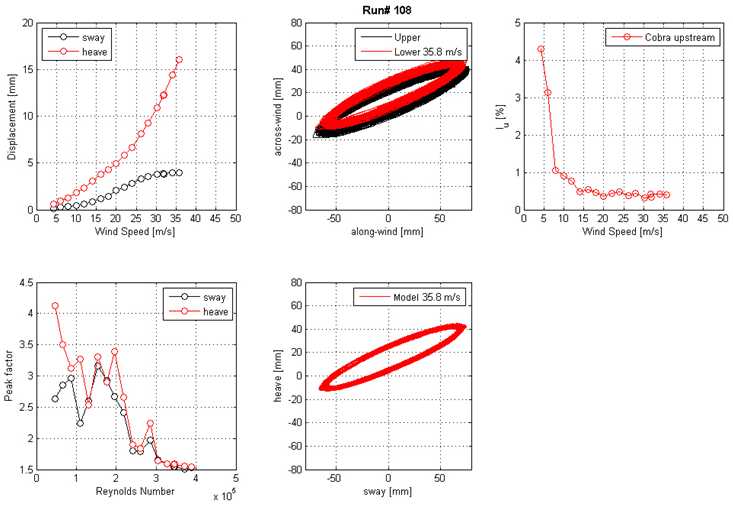 |
| Figure 103. Graph. Mean displacement and peak factor from the laser, motion path at one wind speed, and intensity of turbulence measured at the entrance of the test section for run 108. |
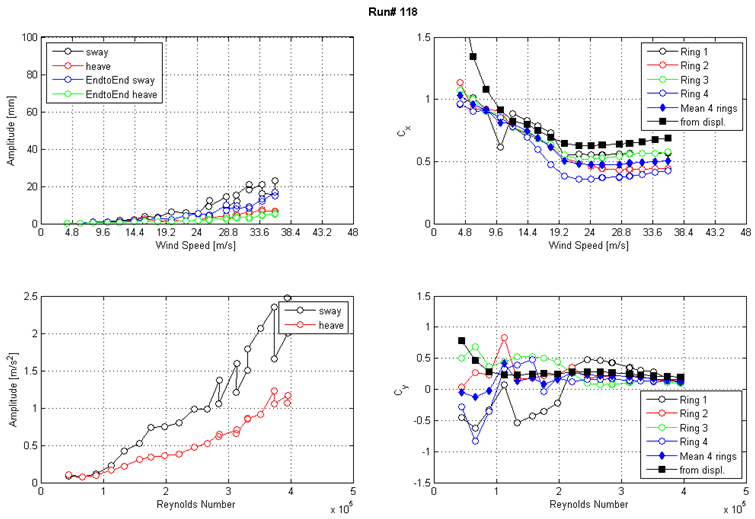 |
| Figure 104. Graph. Response of the cable as a function of wind speed or Reynolds number as measured by the lasers, accelerometers, and surface pressures for run 118. |
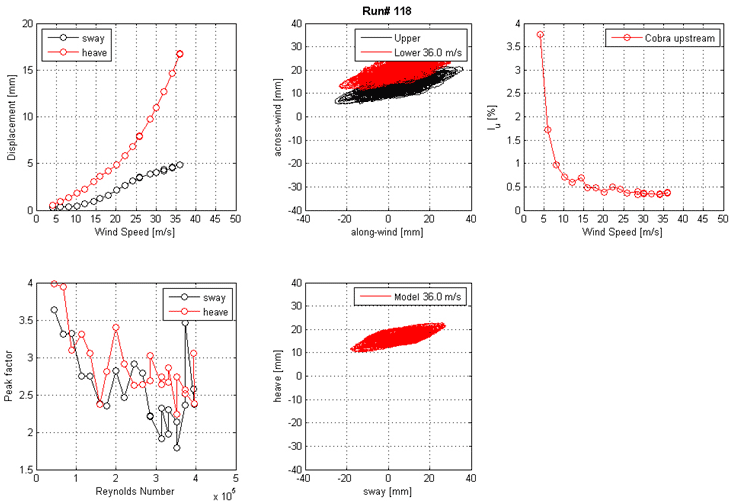 |
| Figure 105. Graph. Mean displacement and peak factor from the laser, motion path at one wind speed, and intensity of turbulence measured at the entrance of the test section for run 118. |
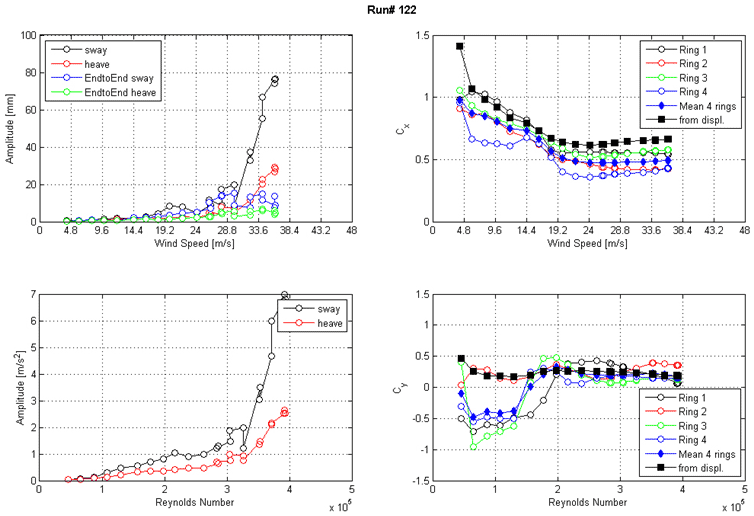 |
| Figure 106. Graph. Response of the cable as a function of wind speed or Reynolds number as measured by the lasers, accelerometers, and surface pressures for run 122. |
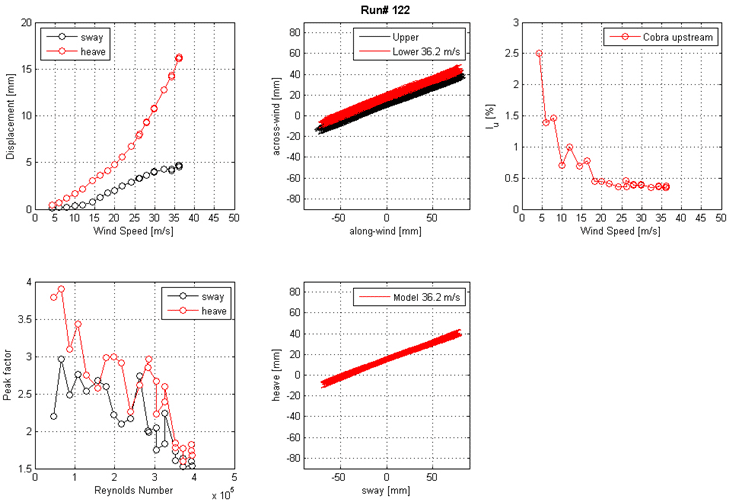 |
| Figure 107. Graph. Mean displacement and peak factor from the laser, motion path at one wind speed, and intensity of turbulence measured at the entrance of the test section for run 122. |
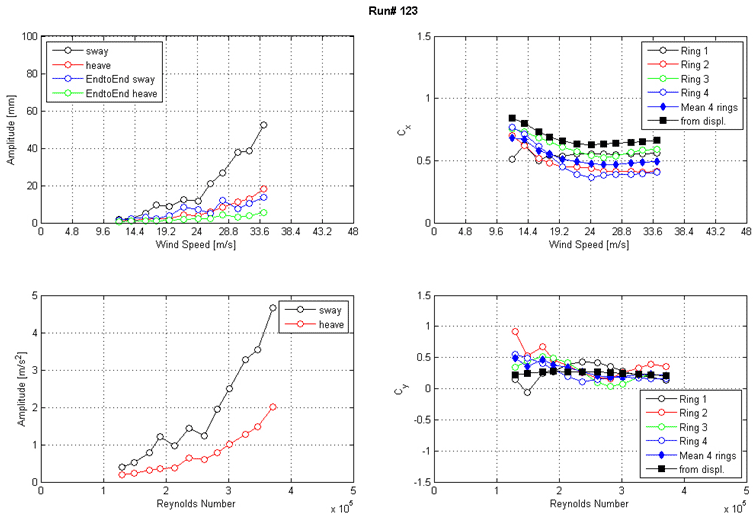 |
| Figure 108. Graph. Response of the cable as a function of wind speed or Reynolds number as measured by the lasers, accelerometers, and surface pressures for run 123. |
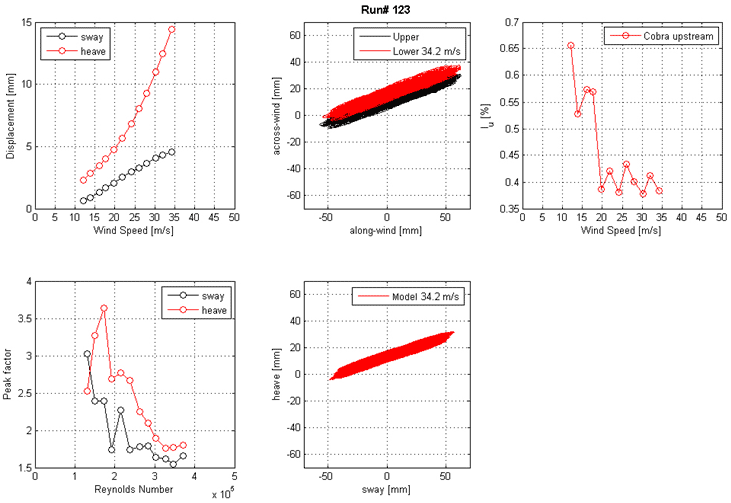 |
| Figure 109. Graph. Mean displacement and peak factor from the laser, motion path at one wind speed, and intensity of turbulence measured at the entrance of the test section for run 123. |
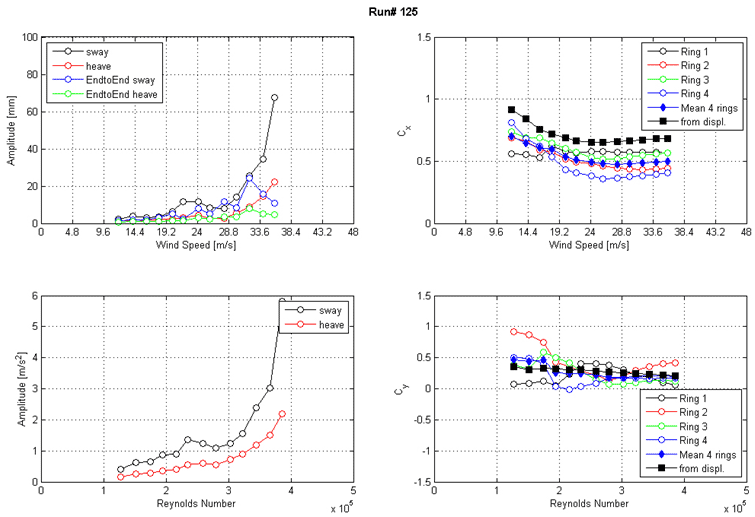 |
| Figure 110. Graph. Response of the cable as a function of wind speed or Reynolds number as measured by the lasers, accelerometers, and surface pressures for run 125. |
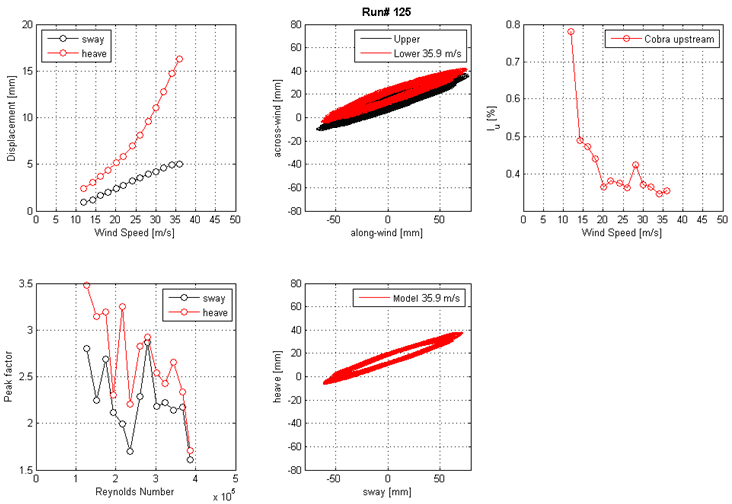 |
| Figure 111. Graph. Mean displacement and peak factor from the laser, motion path at one wind speed, and intensity of turbulence measured at the entrance of the test section for run 125. |
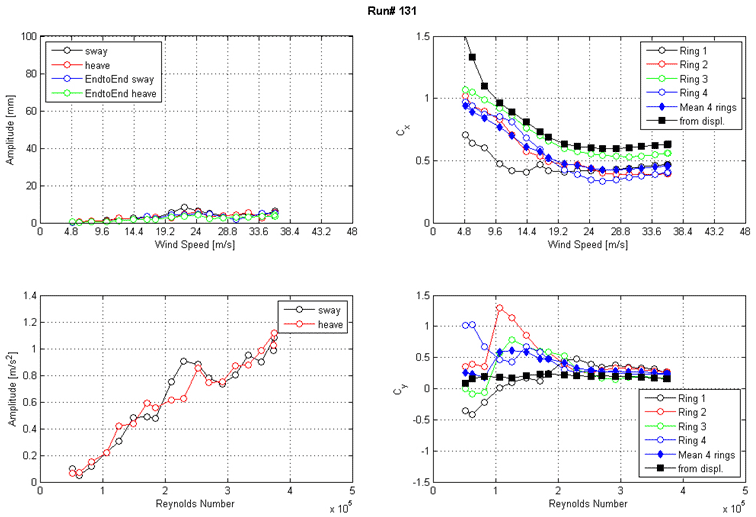 |
| Figure 112. Graph. Response of the cable as a function of wind speed or Reynolds number as measured by the lasers, the accelerometers, and surface pressures for run 131. |
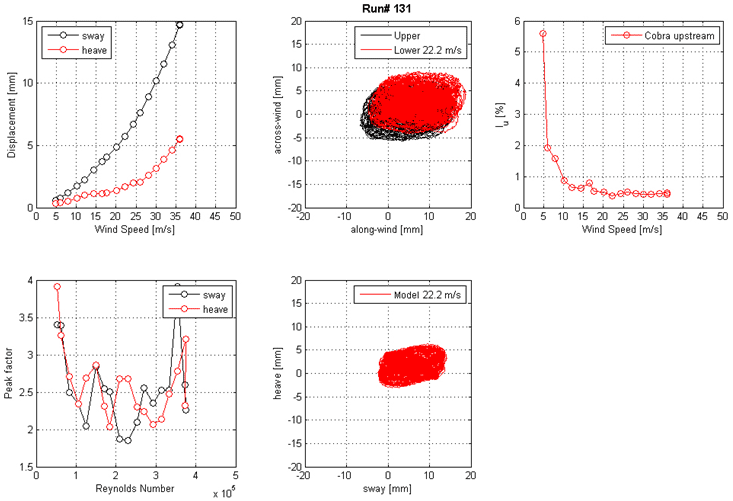 |
| Figure 113. Graph. Mean displacement and peak factor from the laser, motion path at one wind speed, and intensity of turbulence measured at the entrance of the test section for run 131. |
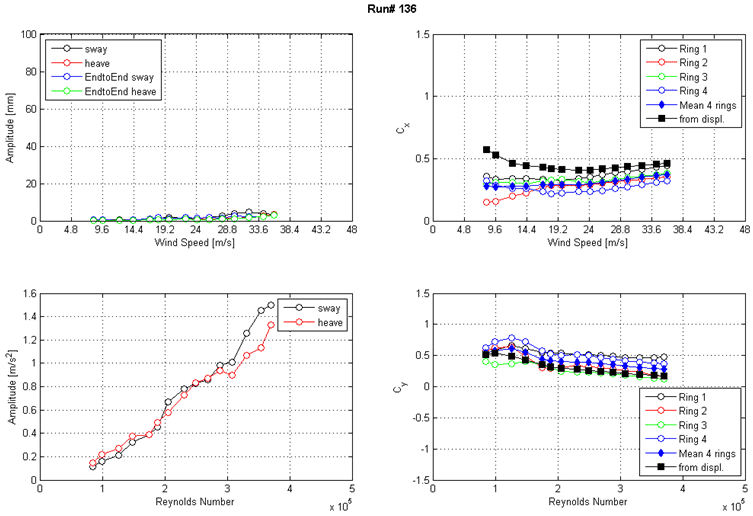 |
| Figure 114. Graph. Response of the cable as a function of wind speed or Reynolds number as measured by the lasers, accelerometers, and surface pressures for run 136. |
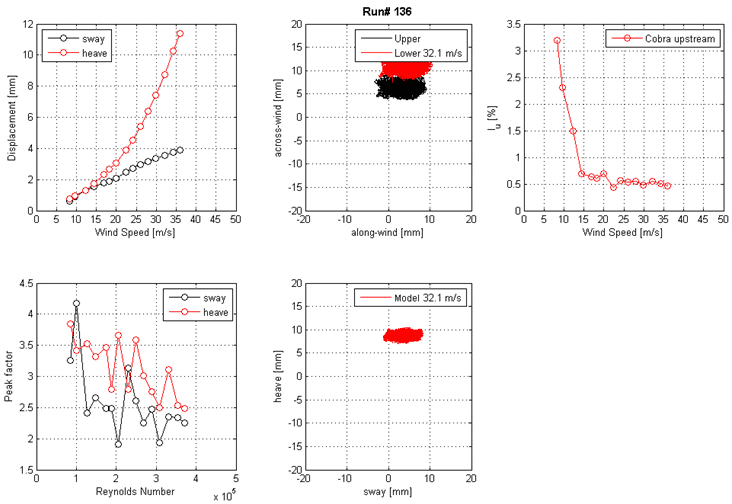 |
| Figure 115. Graph. Mean displacement and peak factor from the laser, motion path at one wind speed, and intensity of turbulence measured at the entrance of the test section for run 136. |
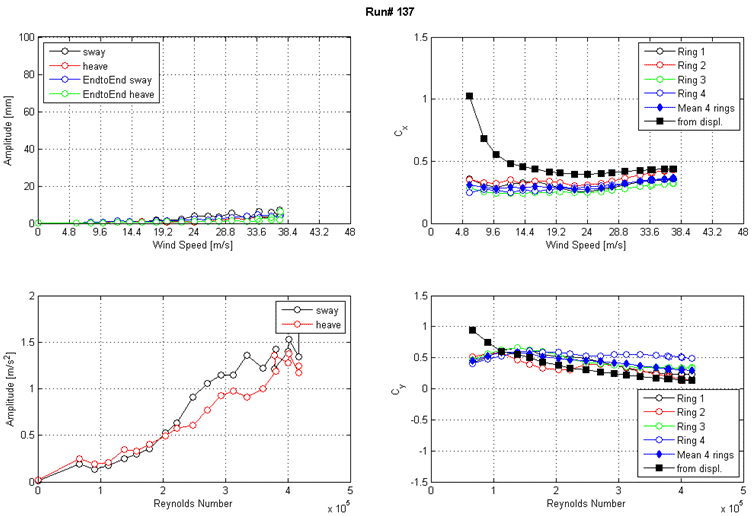 |
| Figure 116. Graph. Response of the cable as a function of wind speed or Reynolds number as measured by the lasers, the accelerometers, and surface pressures for run 137. |
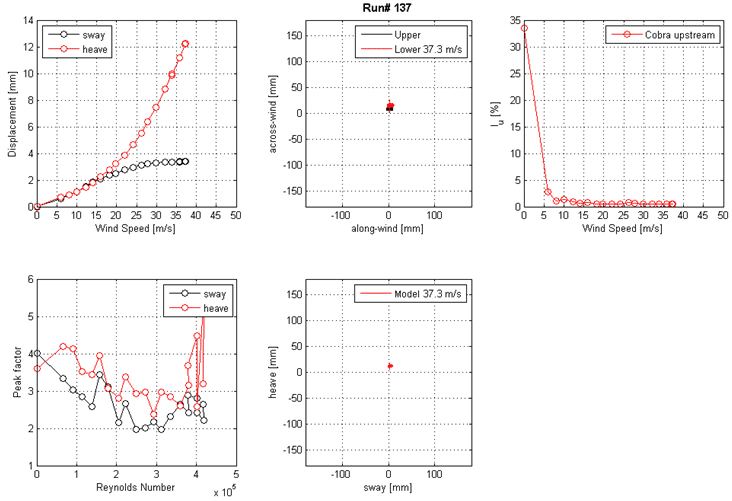 |
| Figure 117. Graph. Mean displacement and peak factor from the laser, motion path at one wind speed, and intensity of turbulence measured at the entrance of the test section for run 137. |
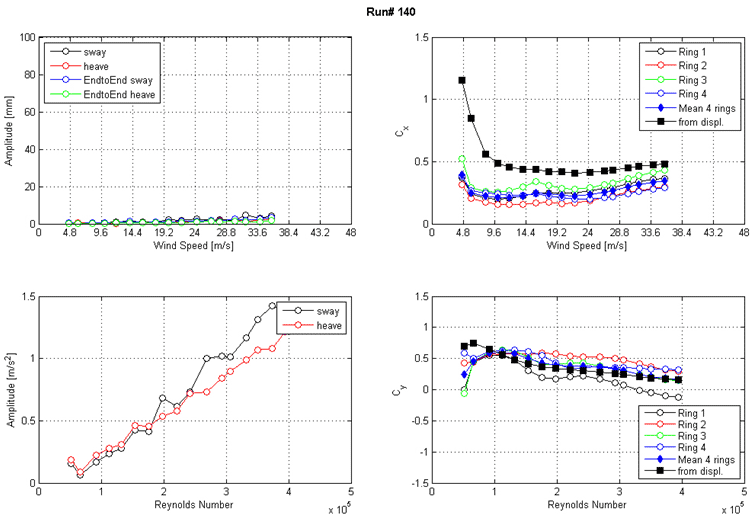 |
| Figure 118. Graph. Response of the cable as a function of wind speed or Reynolds number as measured by the lasers, accelerometers, and surface pressures for run 140. |
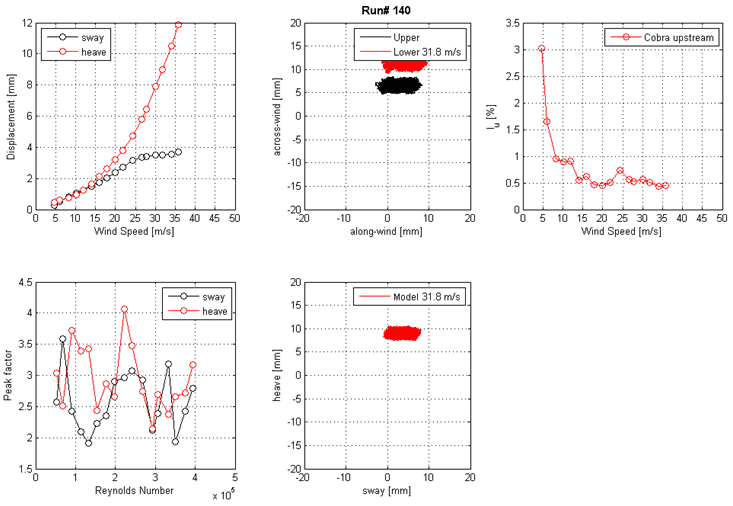 |
| Figure 119. Graph. Mean displacement and peak factor from the laser, motion path at one wind speed, and intensity of turbulence measured at the entrance of the test section for run 140. |
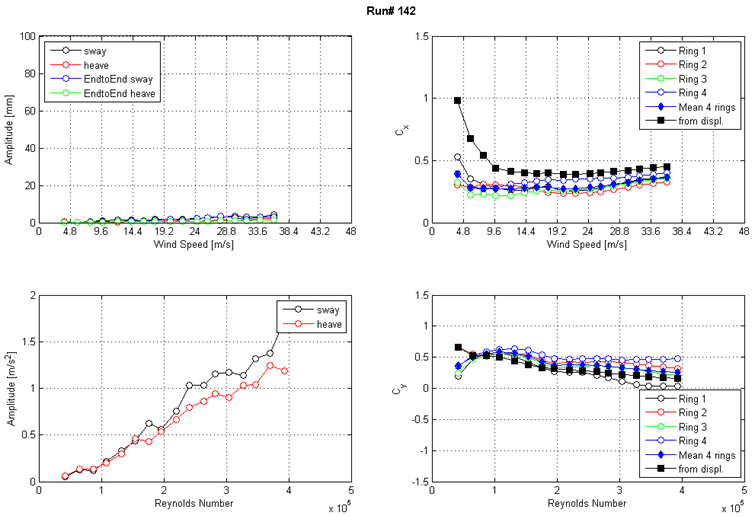 |
| Figure 120. Graph. Response of the cable as a function of wind speed or Reynolds number as measured by the lasers, accelerometers, and surface pressures for run 142. |
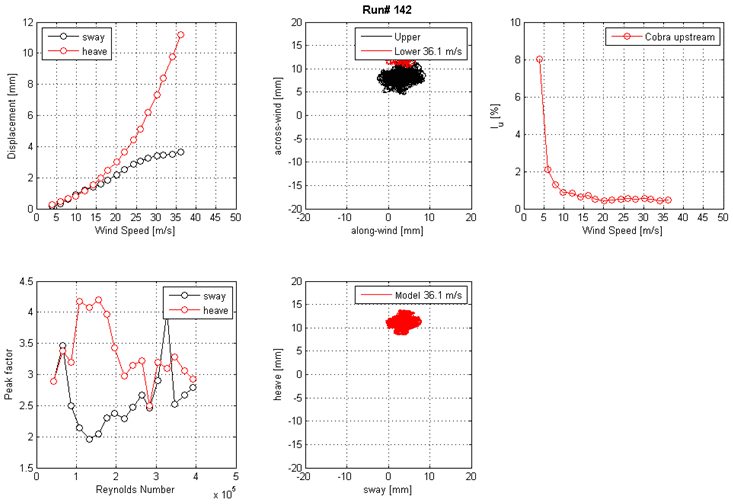 |
| Figure 121. Graph. Mean displacement and peak factor from the laser, motion path at one wind speed, and intensity of turbulence measured at the entrance of the test section for run 142. |
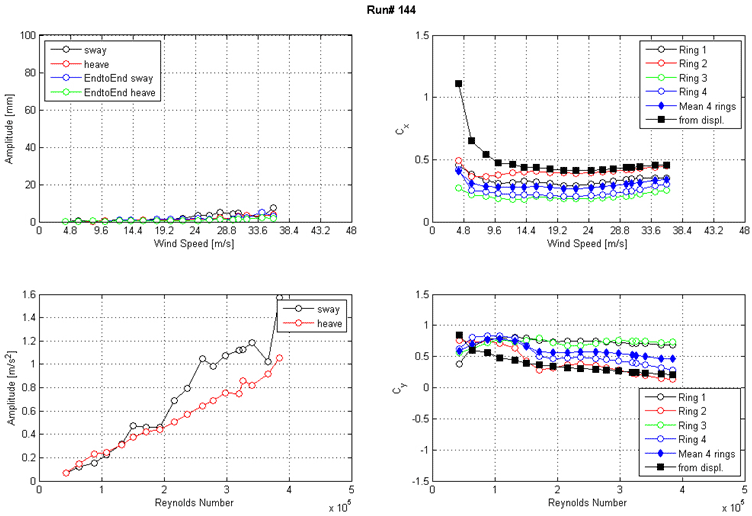 |
| Figure 122. Graph. Response of the cable as a function of wind speed or Reynolds number as measured by the lasers, accelerometers, and surface pressures for run 144. |
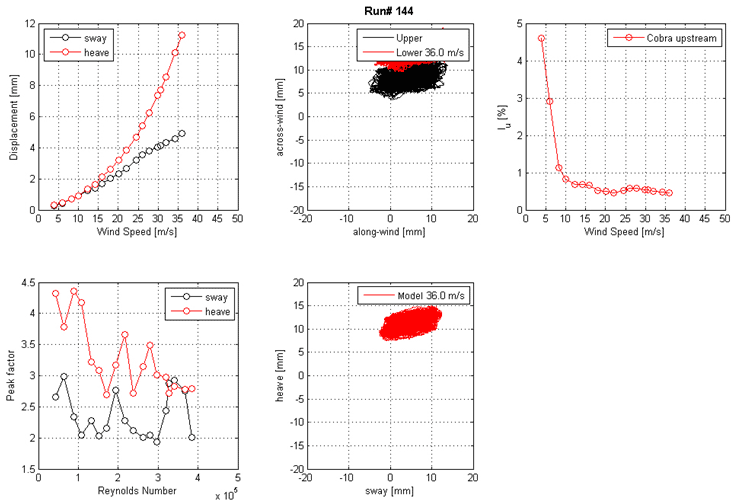 |
| Figure 123. Graph. Mean displacement and peak factor from the laser, motion path at one wind speed, and intensity of turbulence measured at the entrance of the test section for run 144. |
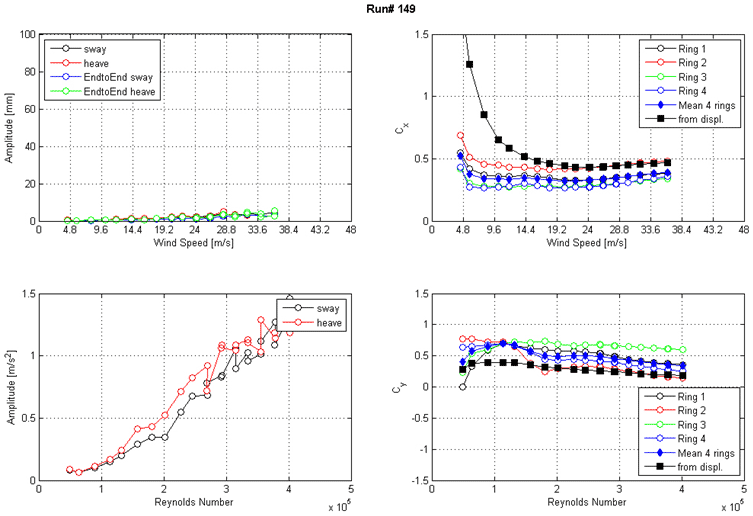 |
| Figure 124. Graph. Response of the cable as a function of wind speed or Reynolds number as measured by the lasers, accelerometers, and surface pressures for run 149. |
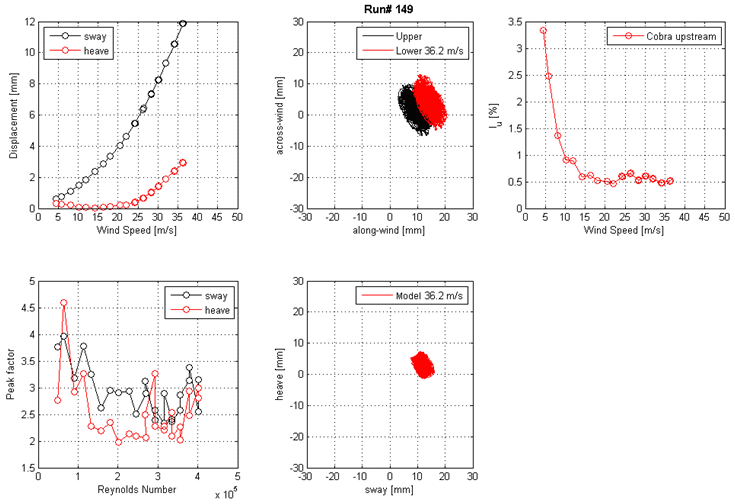 |
| Figure 125. Graph. Mean displacement and peak factor from the laser, motion path at one wind speed, and intensity of turbulence measured at the entrance of the test section for run 149. |
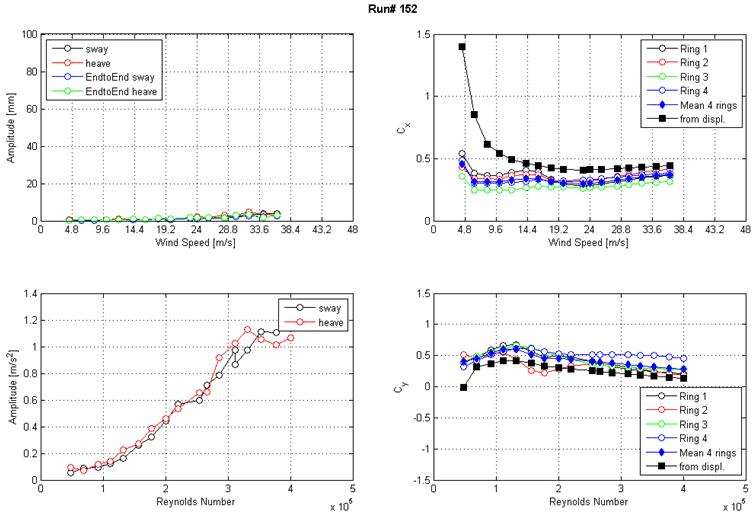 |
| Figure 126. Graph. Response of the cable as a function of wind speed or Reynolds number as measured by the lasers, accelerometers, and surface pressures for run 152. |
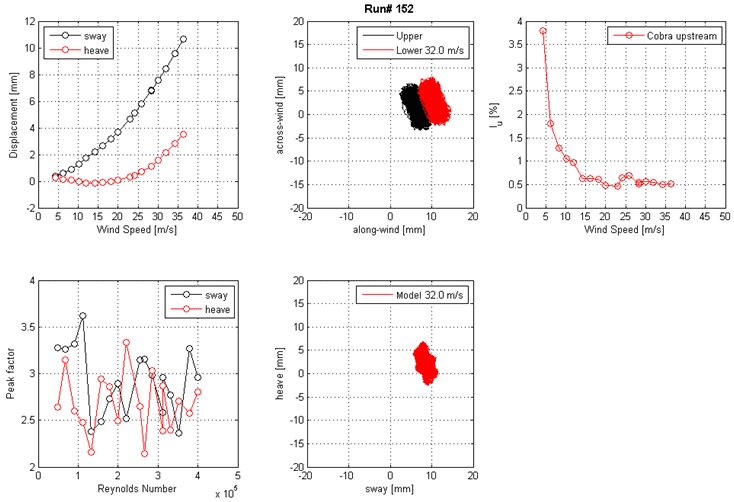 |
| Figure 127. Graph. Mean displacement and peak factor from the laser, motion path at one wind speed, and intensity of turbulence measured at the entrance of the test section for run 152. |
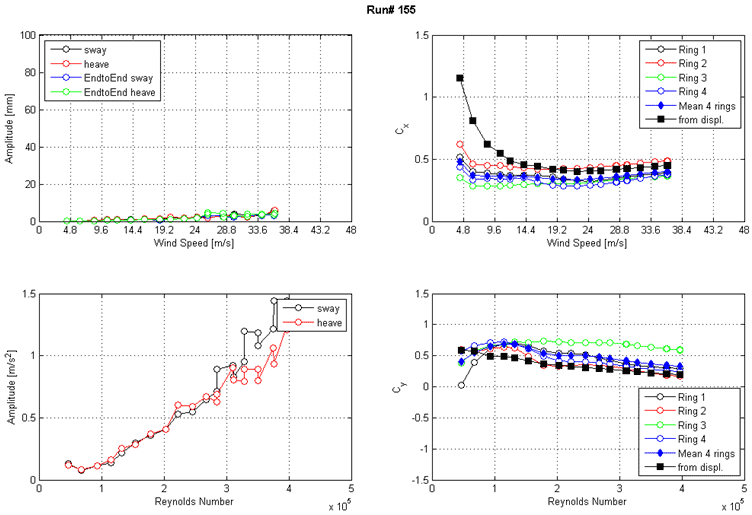 |
| Figure 128. Graph. Response of the cable as a function of wind speed or Reynolds number as measured by the lasers, accelerometers, and surface pressures for run 155. |
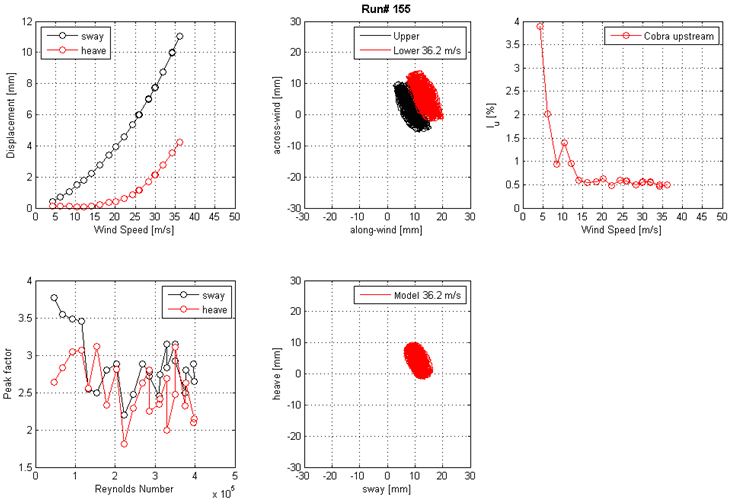 |
| Figure 129. Graph. Mean displacement and peak factor from the laser, motion path at one wind speed, and intensity of turbulence measured at the entrance of the test section for run 155. |
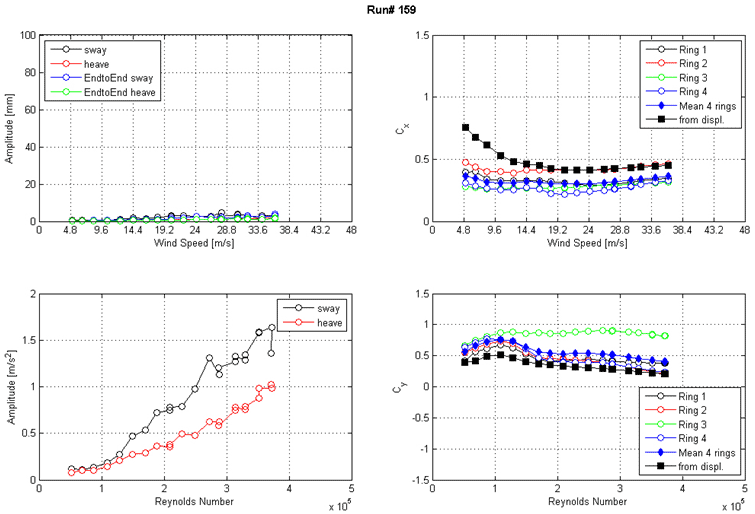 |
| Figure 130. Graph. Response of the cable as a function of wind speed or Reynolds number as measured by the lasers, accelerometers, and surface pressures for run 159. |
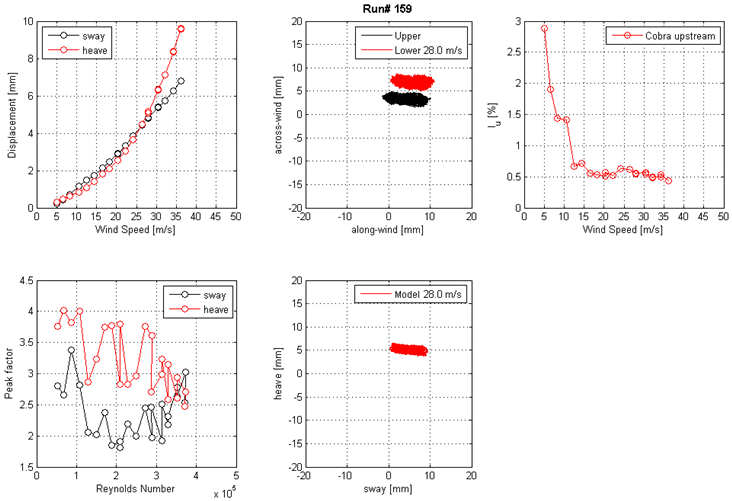 |
| Figure 131. Graph. Mean displacement and peak factor from the laser, motion path at one wind speed, and intensity of turbulence measured at the entrance of the test section for run 159. |
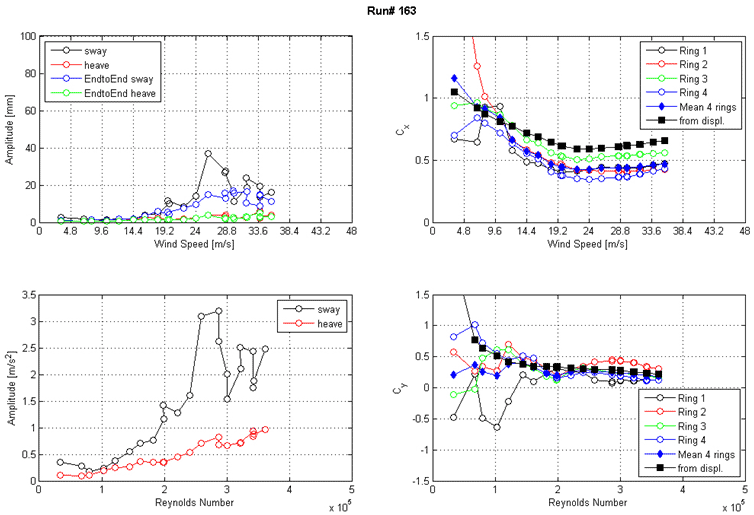 |
| Figure 132. Graph. Response of the cable as a function of wind speed or Reynolds number as measured by the lasers, accelerometers, and surface pressures for run 163. |
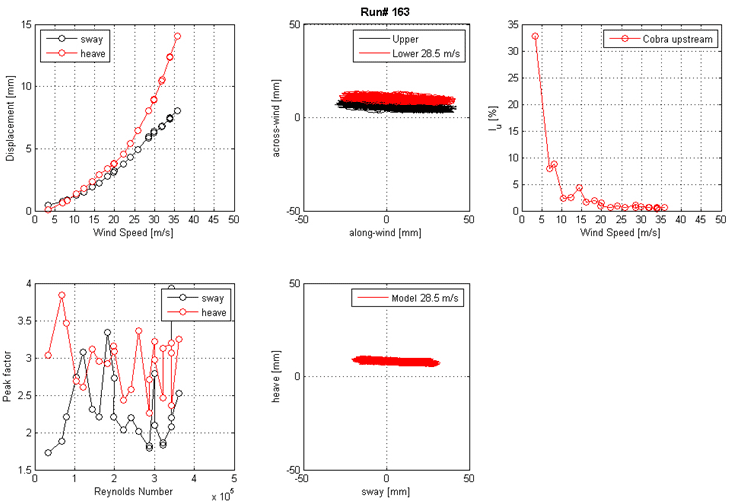 |
| Figure 133. Graph. Mean displacement and peak factor from the laser, motion path at one wind speed, and intensity of turbulence measured at the entrance of the test section for run 163. |
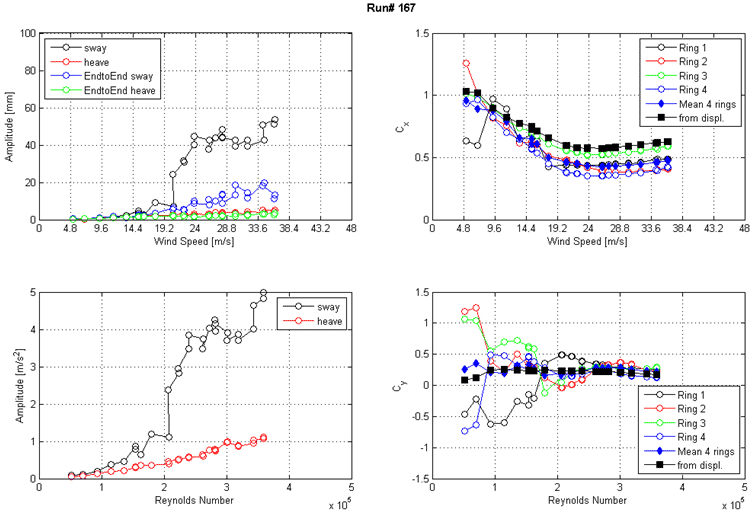 |
| Figure 134. Graph. Response of the cable as a function of wind speed or Reynolds number as measured by the lasers, accelerometers, and surface pressures for run 167. |
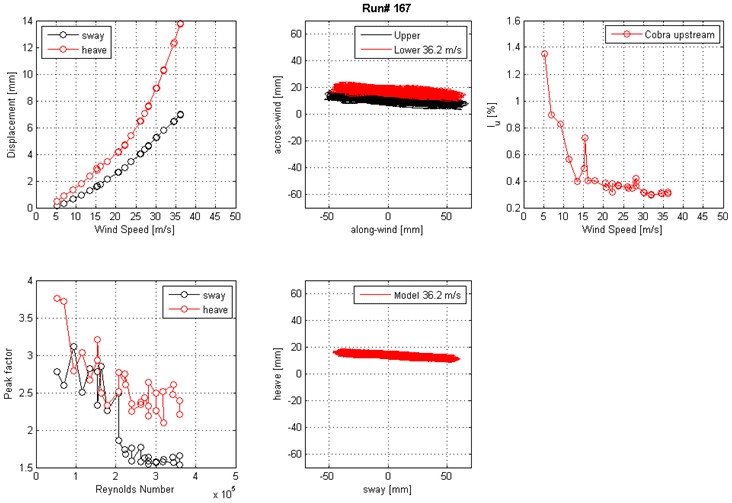 |
| Figure 135. Graph. Mean displacement and peak factor from the laser, motion path at one wind speed, and intensity of turbulence measured at the entrance of the test section for run 167. |
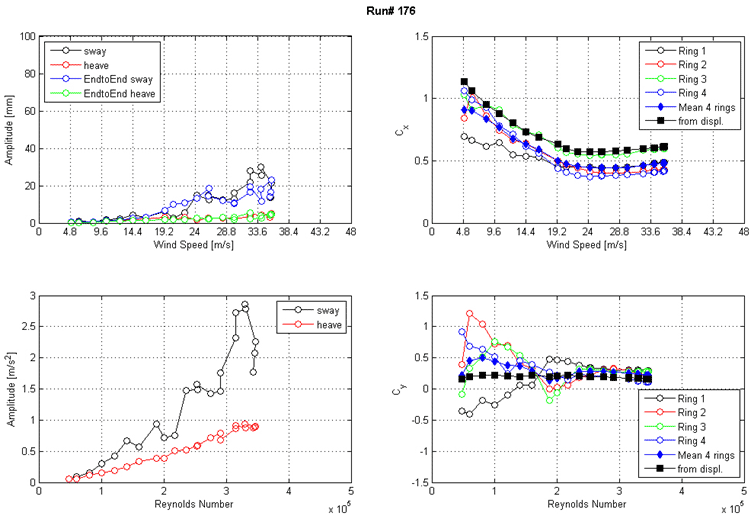 |
| Figure 136. Graph. Response of the cable as a function of wind speed or Reynolds number as measured by the lasers, accelerometers, and surface pressures for run 176. |
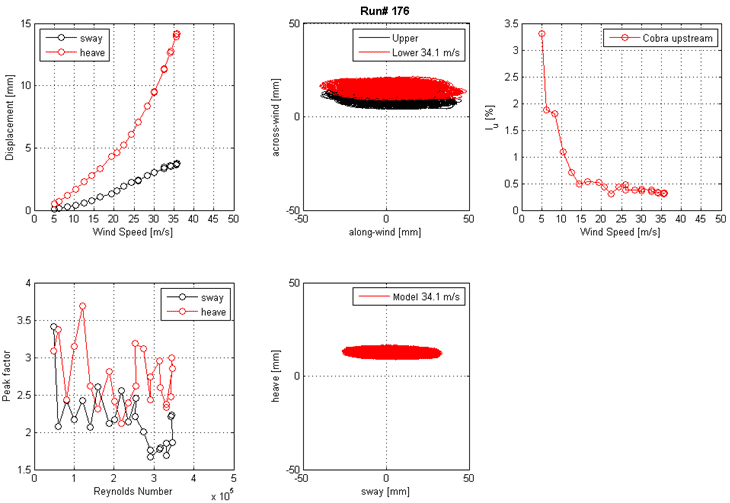 |
| Figure 137. Graph. Mean displacement and peak factor from the laser, motion path at one wind speed, and intensity of turbulence measured at the entrance of the test section for run 176. |
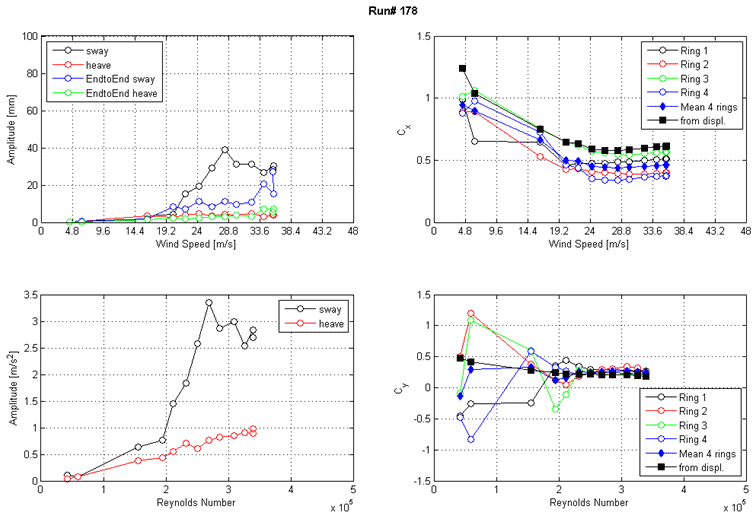 |
| Figure 138. Graph. Response of the cable as a function of wind speed or Reynolds number as measured by the lasers, accelerometers, and surface pressures for run 178. |
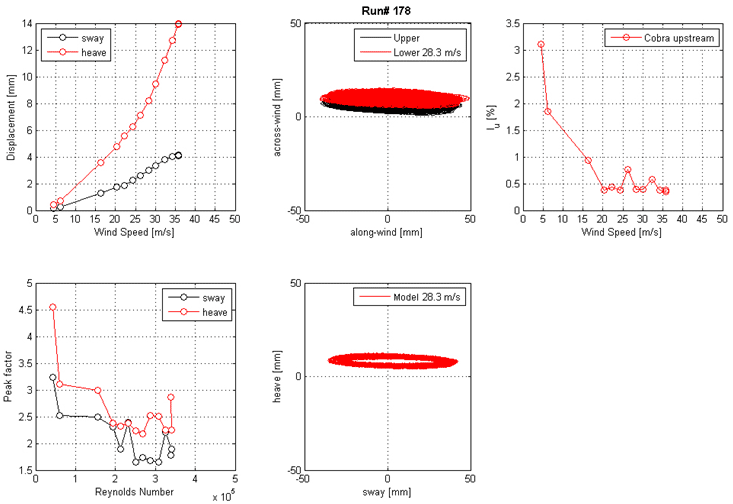 |
| Figure 139. Graph. Mean displacement and peak factor from the laser, motion path at one wind speed, and intensity of turbulence measured at the entrance of the test section for run 178. |
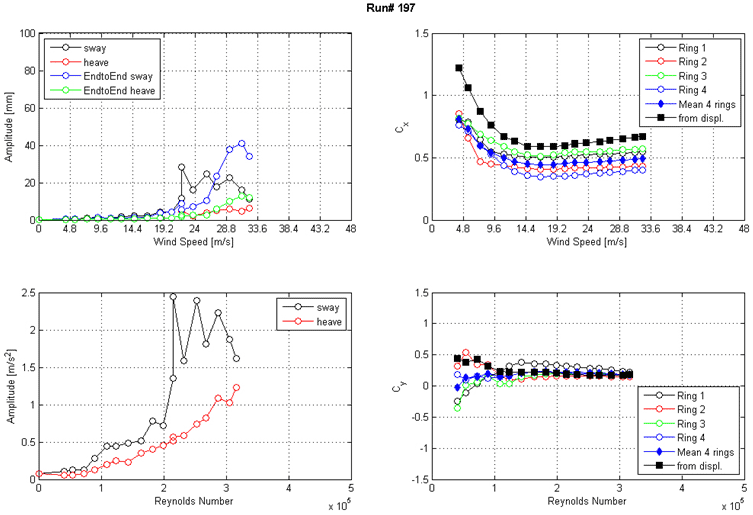 |
| Figure 140. Graph. Response of the cable as a function of wind speed or Reynolds number as measured by the lasers, accelerometers, and surface pressures for run 197. |
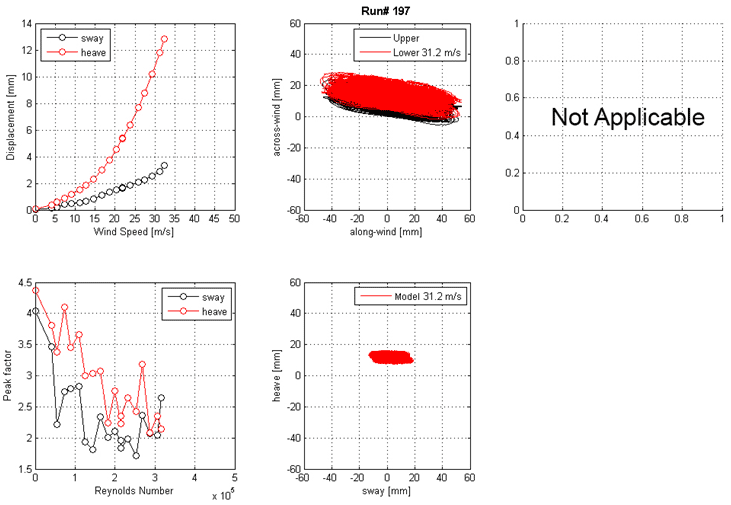 |
| Figure 141. Graph. Mean displacement and peak factor from the laser, motion path at one wind speed, and intensity of turbulence measured at the entrance of the test section for run 197. |
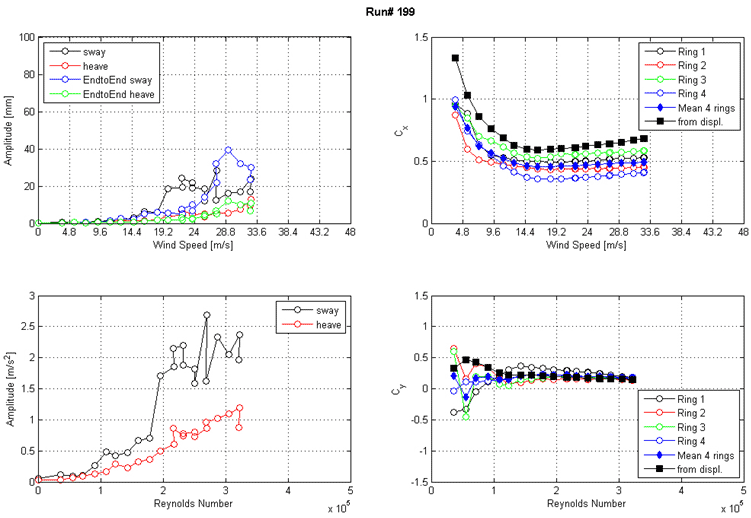 |
| Figure 142. Graph. Response of the cable as a function of wind speed or Reynolds number as measured by the lasers, accelerometers, and surface pressures for run 199. |
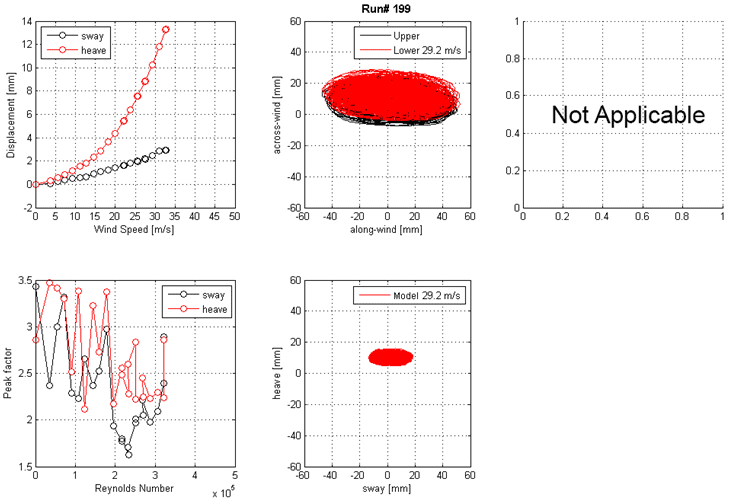 |
| Figure 143. Graph. Mean displacement and peak factor from the laser, motion path at one wind speed, and intensity of turbulence measured at the entrance of the test section for run 199. |
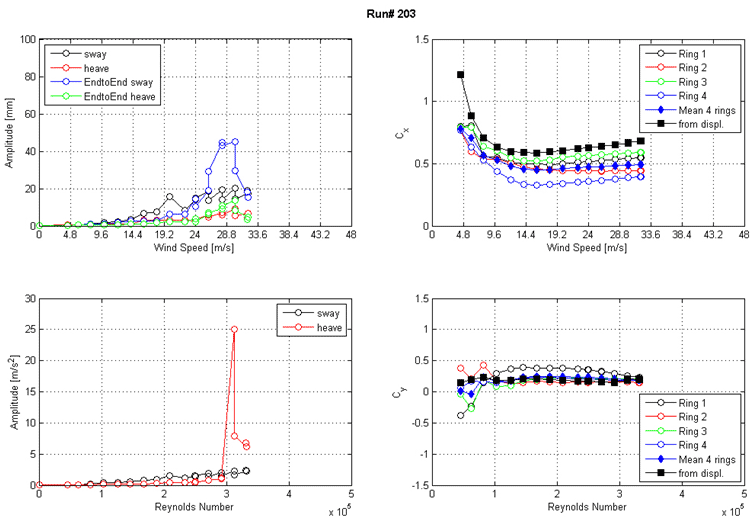 |
| Figure 144. Graph. Response of the cable as a function of wind speed or Reynolds number as measured by the lasers, accelerometers, and surface pressures for run 203. |
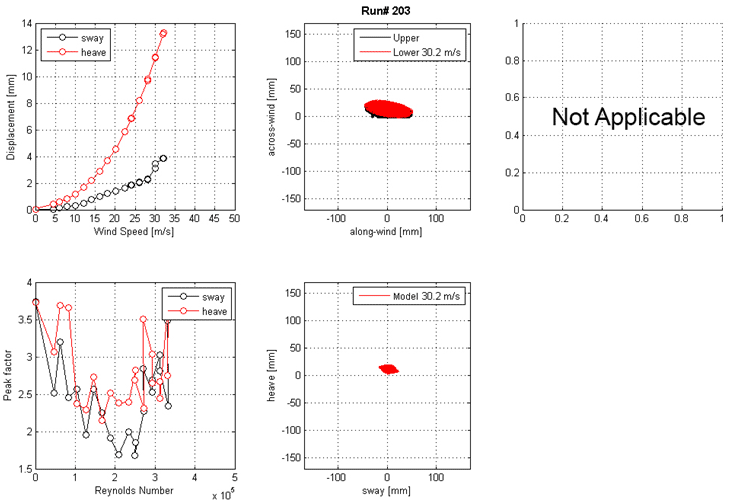 |
| Figure 145. Graph. Mean displacement and peak factor from the laser, motion path at one wind speed, and intensity of turbulence measured at the entrance of the test section for run 203. |
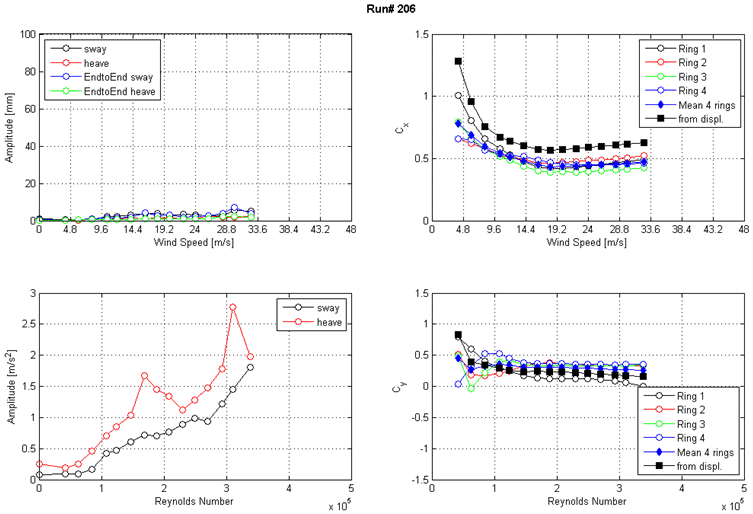 |
| Figure 146. Graph. Response of the cable as a function of wind speed or Reynolds number as measured by the lasers, accelerometers, and surface pressures for run 206. |
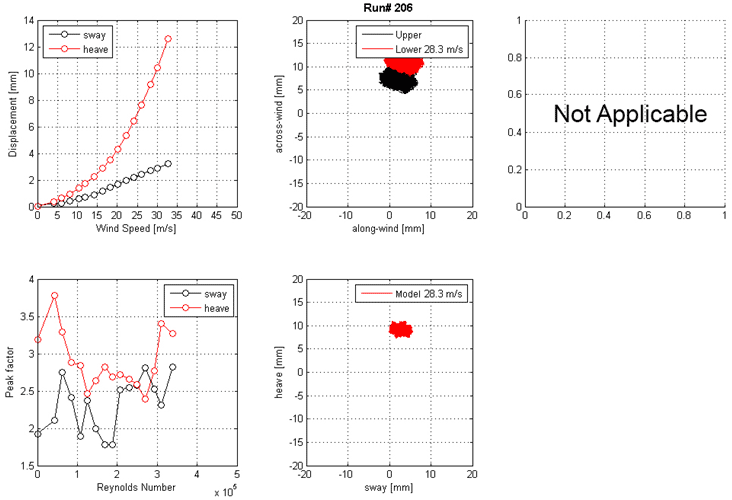 |
| Figure 147. Graph. Mean displacement and peak factor from the laser, motion path at one wind speed, and intensity of turbulence measured at the entrance of the test section for run 206. |
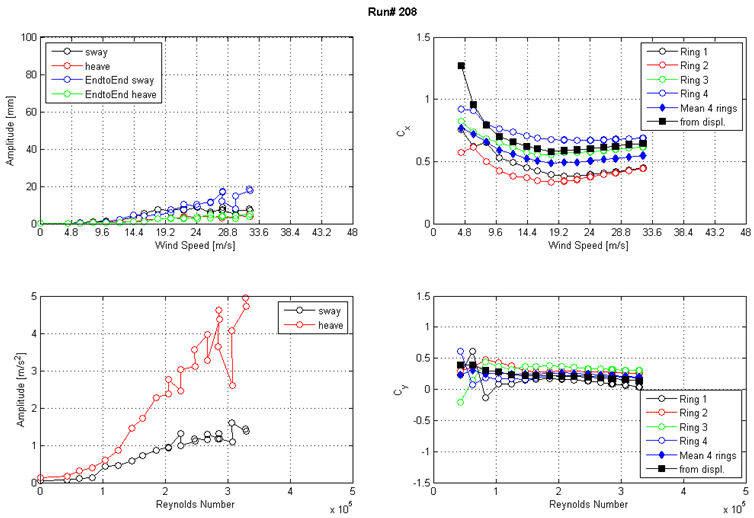 |
| Figure 148. Graph. Response of the cable as a function of wind speed or Reynolds number as measured by the lasers, accelerometers, and surface pressures for run 208. |
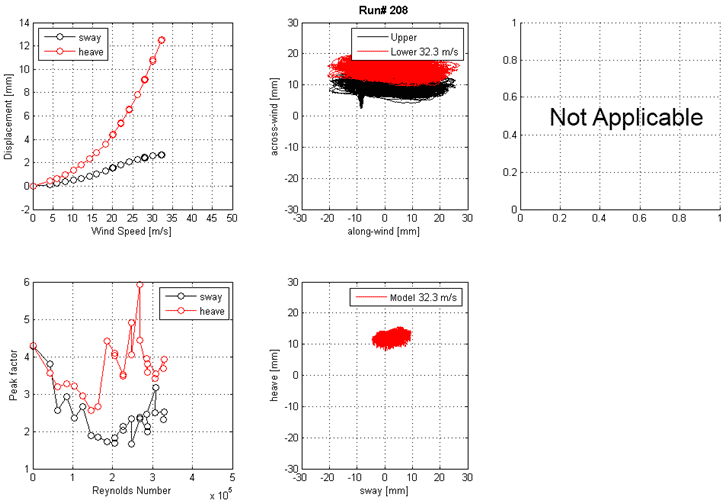 |
| Figure 149. Graph. Mean displacement and peak factor from the laser, motion path at one wind speed, and intensity of turbulence measured at the entrance of the test section for run 208. |
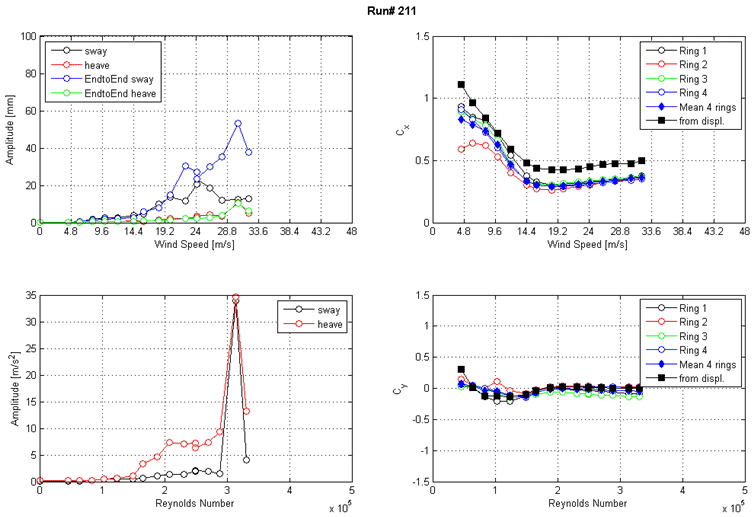 |
| Figure 150. Graph. Response of the cable as a function of wind speed or Reynolds number as measured by the lasers, accelerometers, and surface pressures for run 211. |
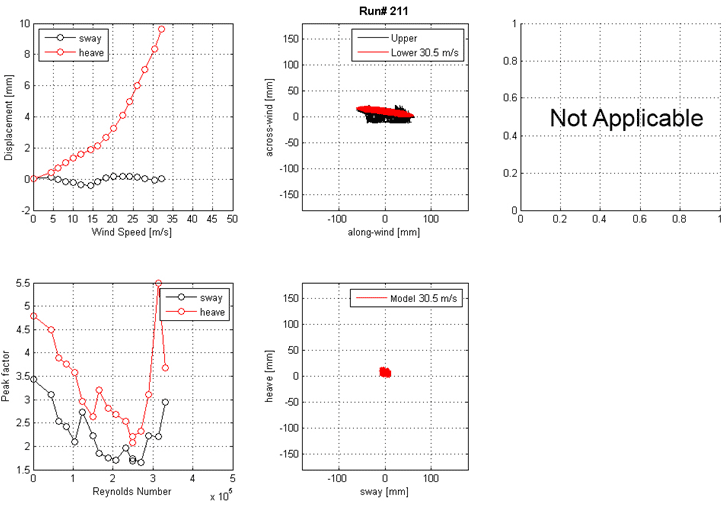 |
| Figure 151. Graph. Mean displacement and peak factor from the laser, motion path at one wind speed, and intensity of turbulence measured at the entrance of the test section for run 211. |
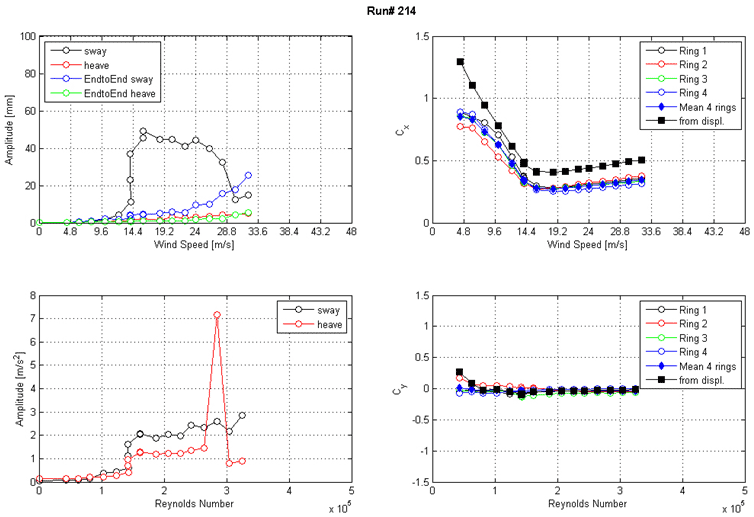 |
| Figure 152. Graph. Response of the cable as a function of wind speed or Reynolds number as measured by the lasers, accelerometers, and surface pressures for run 214. |
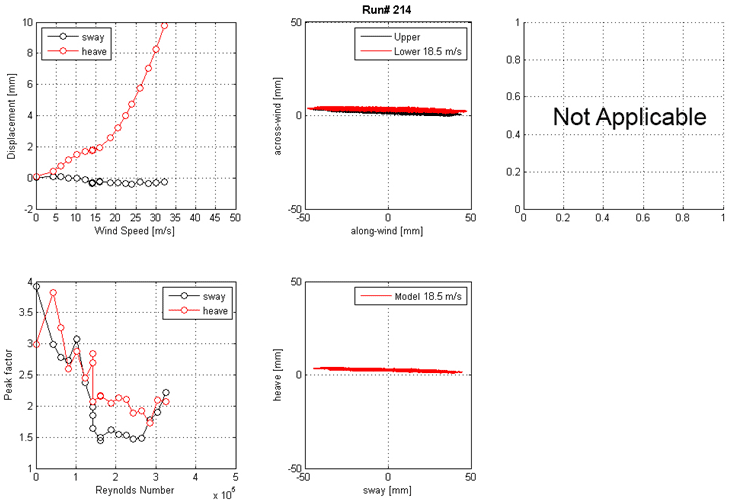 |
| Figure 153. Graph. Mean displacement and peak factor from the laser, motion path at one wind speed, and intensity of turbulence measured at the entrance of the test section for run 214. |
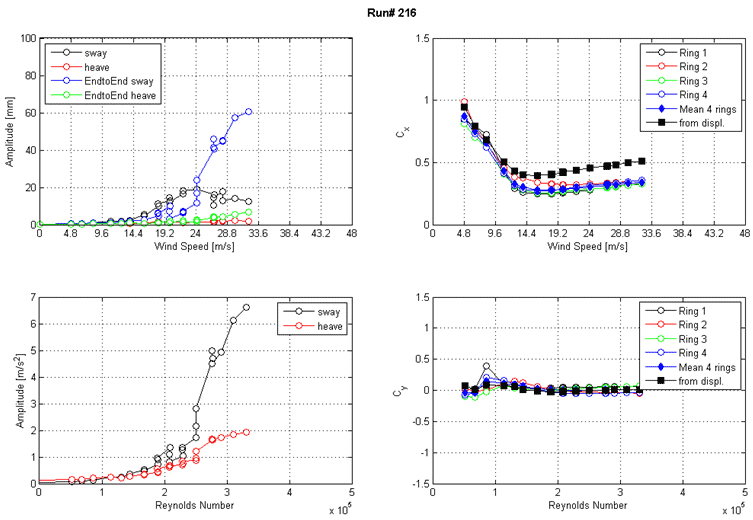 |
| Figure 154. Graph. Response of the cable as a function of wind speed or Reynolds number as measured by the lasers, accelerometers, and surface pressures for run 216. |
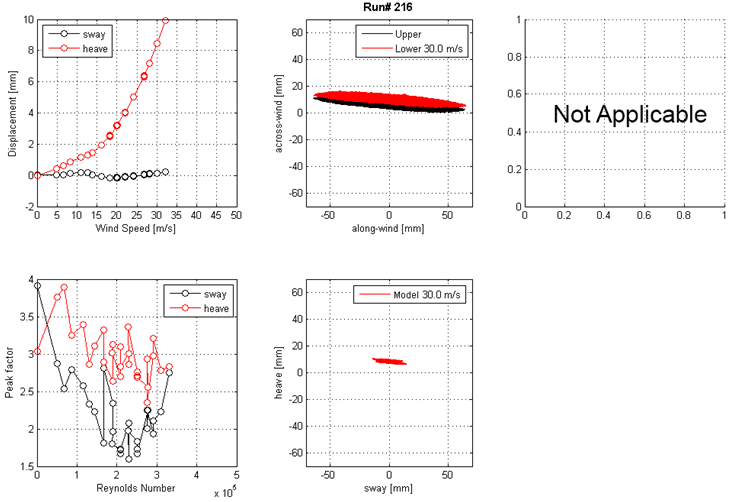 |
| Figure 155. Graph. Mean displacement and peak factor from the laser, motion path at one wind speed, and intensity of turbulence measured at the entrance of the test section for run 216. |
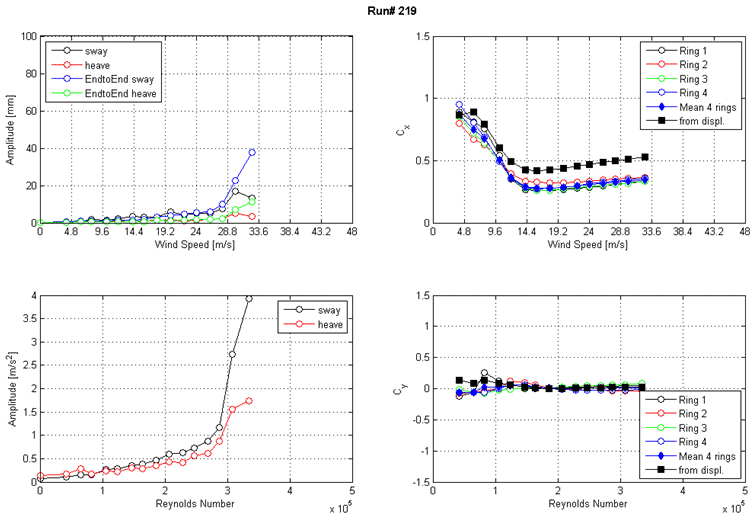 |
| Figure 156. Graph. Response of the cable as a function of wind speed or Reynolds number as measured by the lasers, accelerometers, and surface pressures for run 219. |
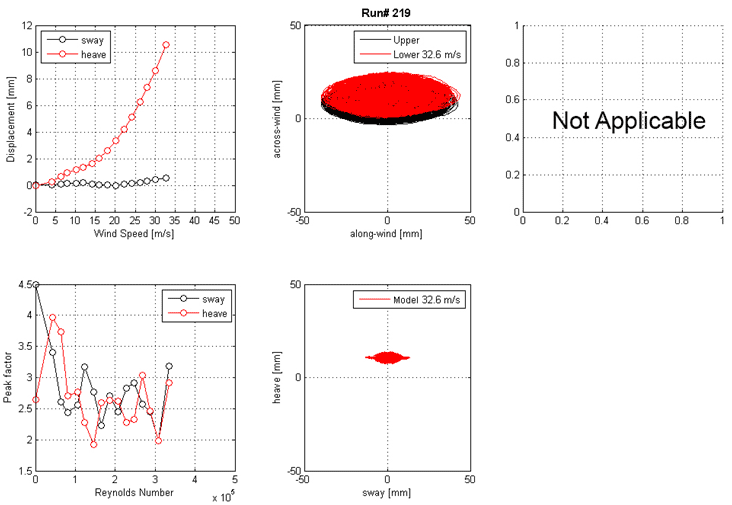 |
| Figure 157. Graph. Mean displacement and peak factor from the laser, motion path at one wind speed, and intensity of turbulence measured at the entrance of the test section for run 219. |
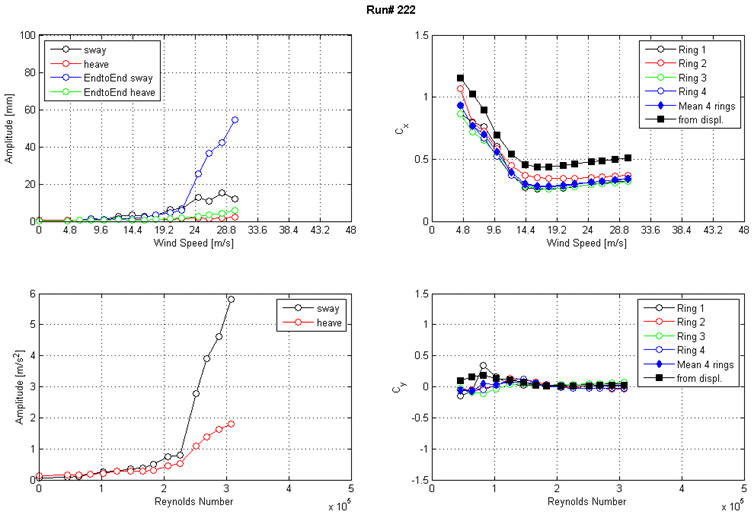 |
| Figure 158. Graph. Response of the cable as a function of wind speed or Reynolds number as measured by the lasers, accelerometers, and surface pressures for run 222. |
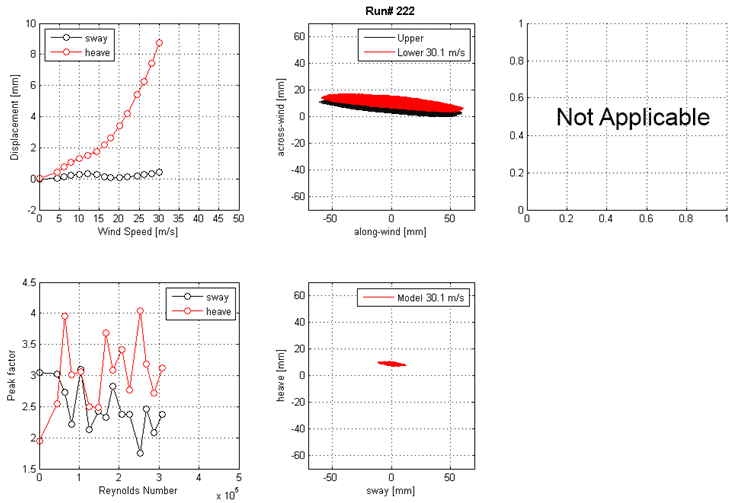 |
| Figure 159. Graph. Mean displacement and peak factor from the laser, motion path at one wind speed, and intensity of turbulence measured at the entrance of the test section for run 222. |
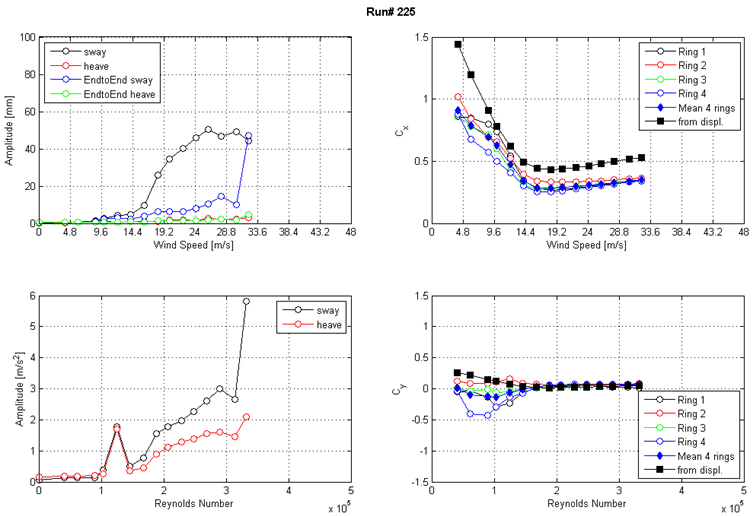 |
| Figure 160. Graph. Response of the cable as a function of wind speed or Reynolds number as measured by the lasers, accelerometers, and surface pressures for run 225. |
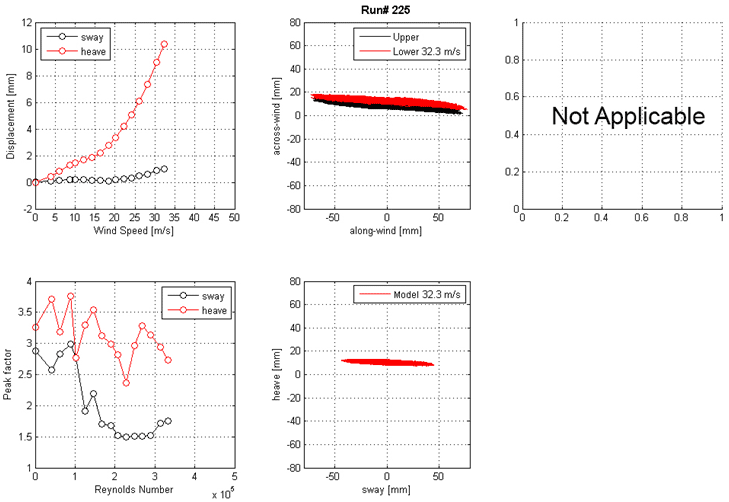 |
| Figure 161. Graph. Mean displacement and peak factor from the laser, motion path at one wind speed, and intensity of turbulence measured at the entrance of the test section for run 225. |
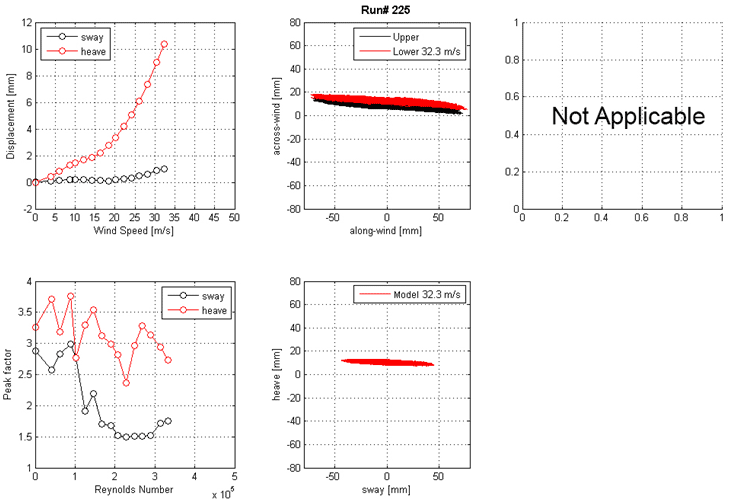 |
| Figure 162. Graph. Response of the cable as a function of wind speed or Reynolds number as measured by the lasers, accelerometers, and surface pressures for run 226. |
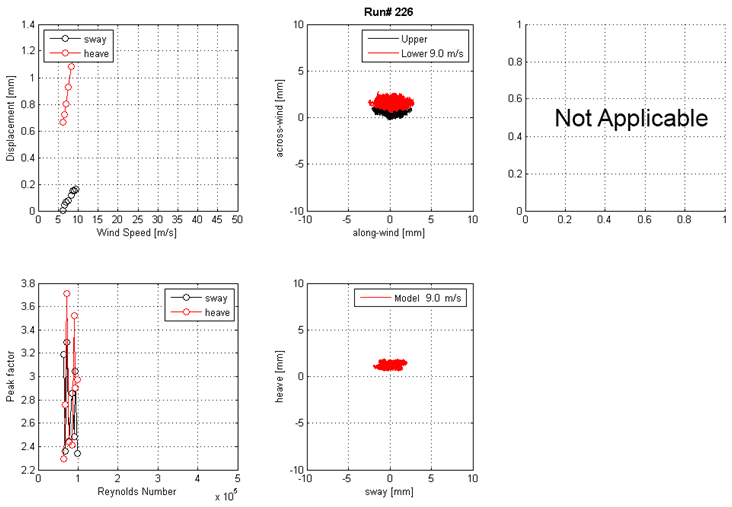 |
| Figure 163. Graph. Mean displacement and peak factor from the laser, motion path at one wind speed. and intensity of turbulence measured at the entrance of the test section for run 226. |
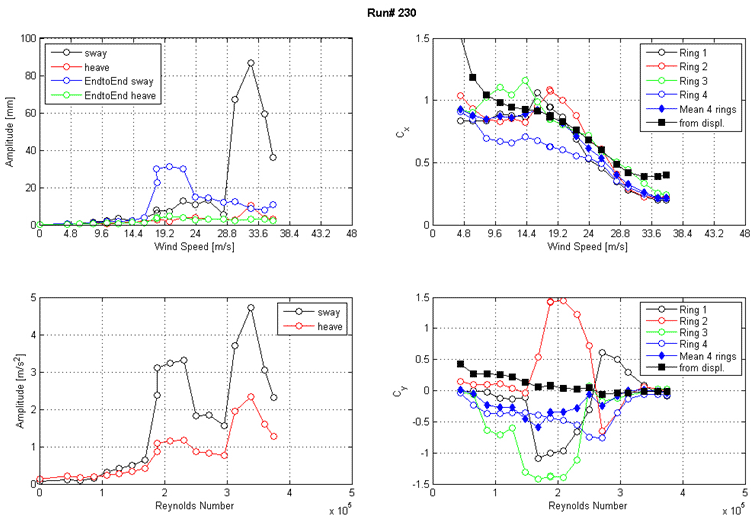 |
| Figure 164. Graph. Response of the cable as a function of wind speed or Reynolds number as measured by the lasers, accelerometers, and surface pressures for run 230. |
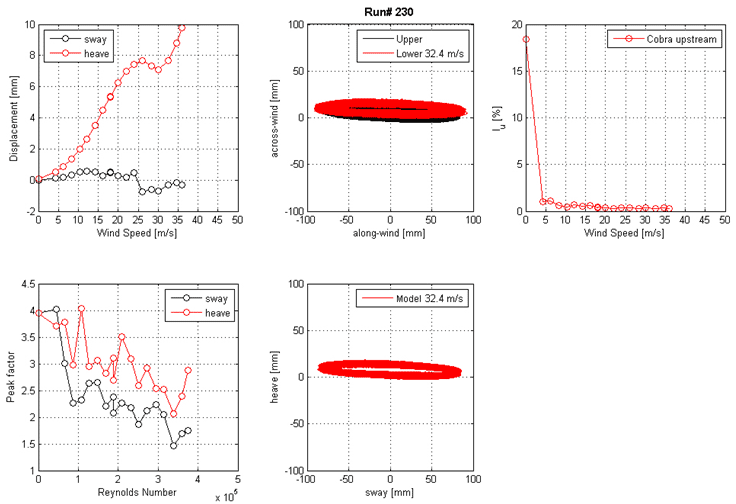 |
| Figure 165. Graph. Mean displacement and peak factor from the laser, motion path at one wind speed, and intensity of turbulence measured at the entrance of the test section for run 230. |
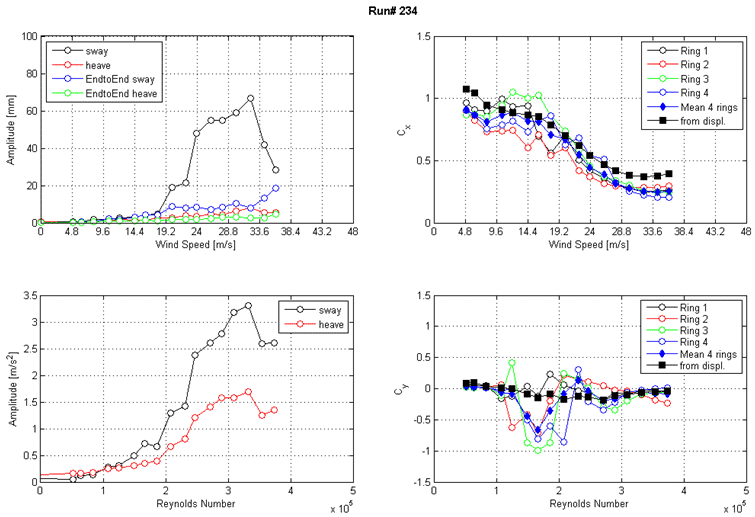 |
| Figure 166. Graph. Response of the cable as a function of wind speed or Reynolds number as measured by the lasers, accelerometers, and surface pressures for run 234. |
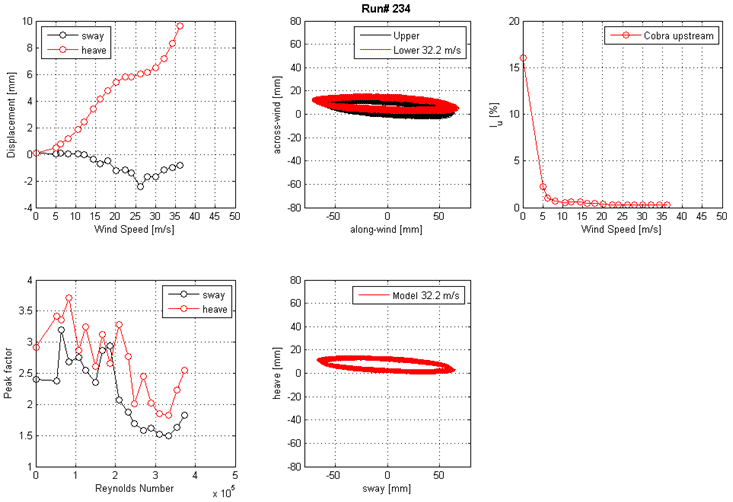 |
| Figure 167. Graph. Mean displacement and peak factor from the laser, motion path at one wind speed, and intensity of turbulence measured at the entrance of the test section for run 234. |
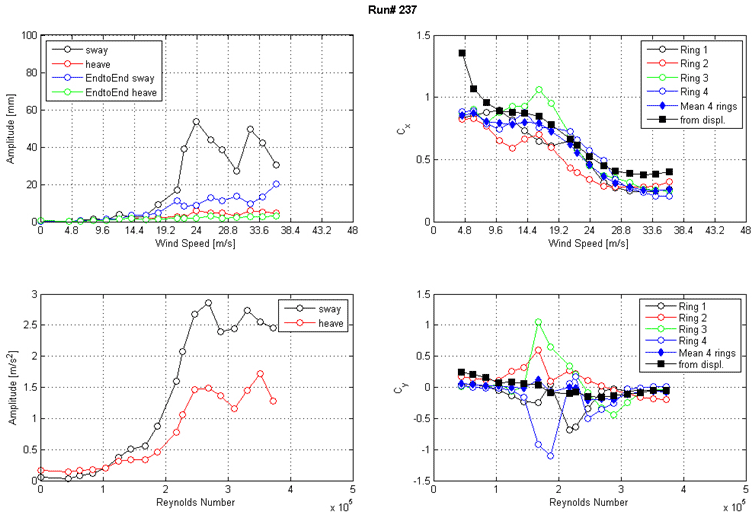 |
| Figure 168. Graph. Response of the cable as a function of wind speed or Reynolds number as measured by the lasers, accelerometers, and surface pressures for run 237. |
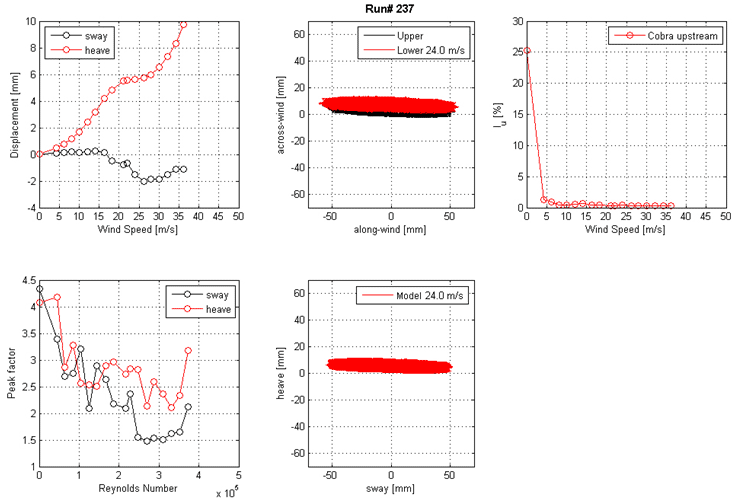 |
| Figure 169. Graph. Mean displacement and peak factor from the laser, motion path at one wind speed, and intensity of turbulence measured at the entrance of the test section for run 237. |
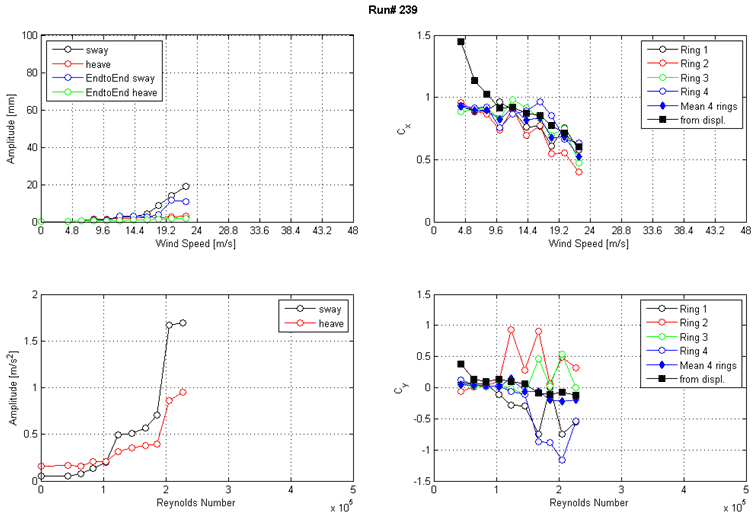 |
| Figure 170. Graph. Response of the cable as a function of wind speed or Reynolds number as measured by the lasers, accelerometers, and surface pressures for run 239. |
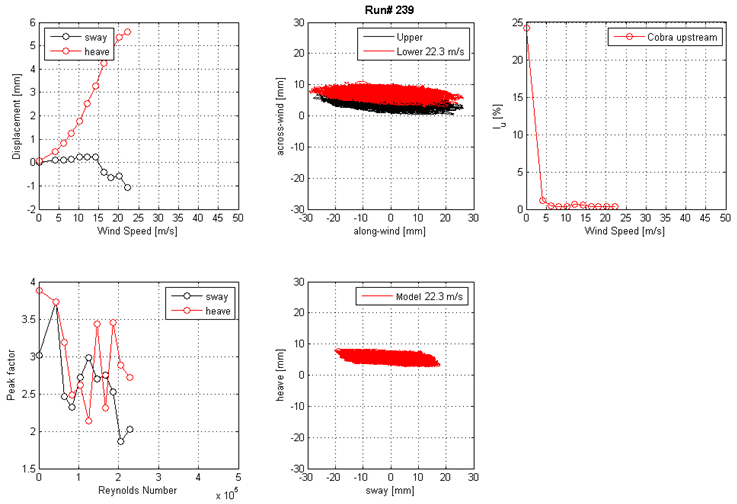 |
| Figure 171. Graph. Mean displacement and peak factor from the laser, motion path at one wind speed, and intensity of turbulence measured at the entrance of the test section for run 239. |
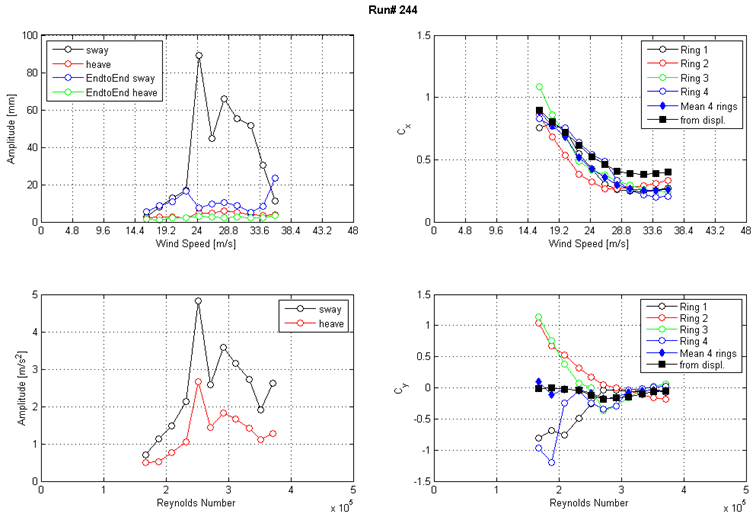 |
| Figure 172. Graph. Response of the cable as a function of wind speed or Reynolds number as measured by the lasers, accelerometers, and surface pressures for run 244. |
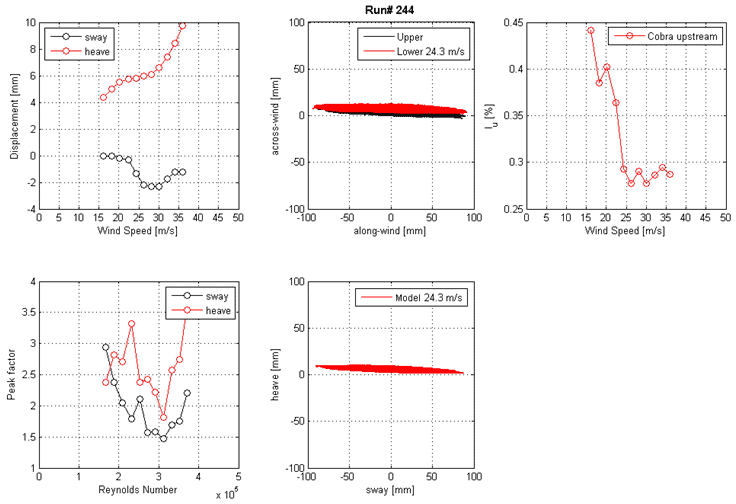 |
| Figure 173. Graph. Mean displacement and peak factor from the laser, motion path at one wind speed, and intensity of turbulence measured at the entrance of the test section for run 244. |
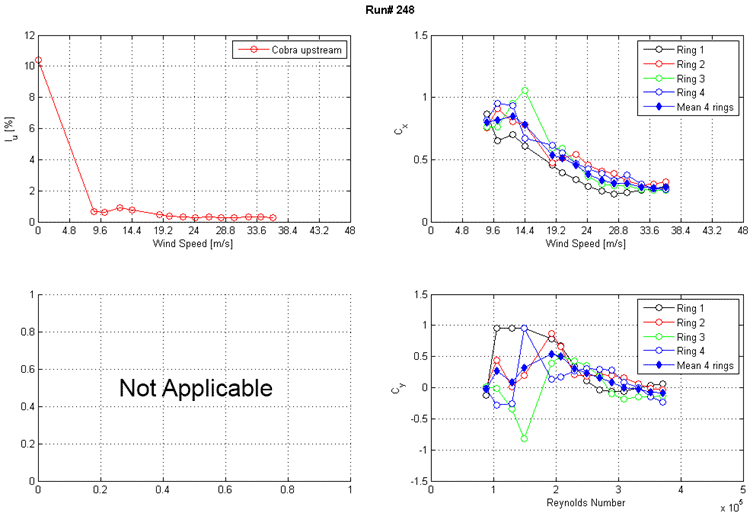 |
| Figure 174. Graph. Intensity of turbulence measured at the entrance of the test section and Cx and Cy calculated from surface pressure measurements as a function of Reynolds number and wind speed for run 248. |
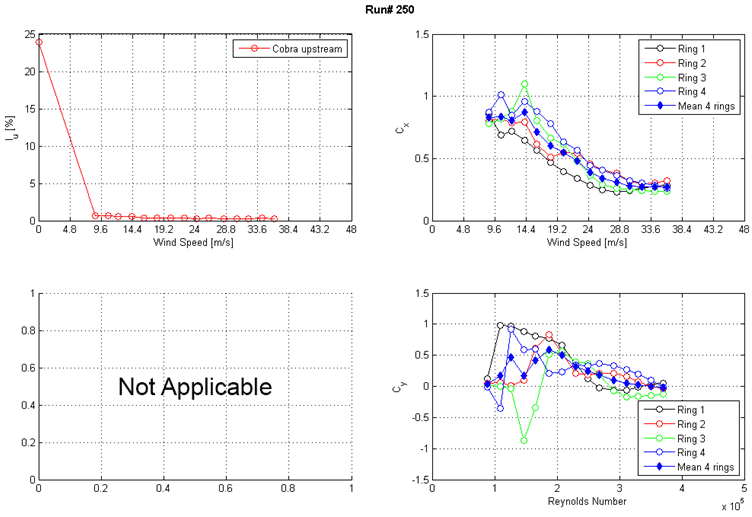 |
| Figure 175. Graph. Intensity of turbulence measured at the entrance of the test section and Cx and Cy calculated from surface pressure measurements as a function of Reynolds number and wind speed for run 250. |
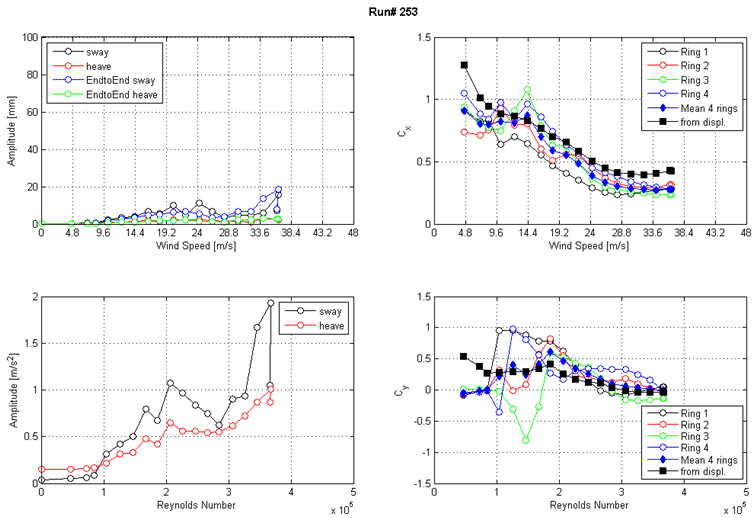 |
| Figure 176. Graph. Response of the cable as a function of wind speed or Reynolds number as measured by the lasers, accelerometers, and surface pressures for run 253. |
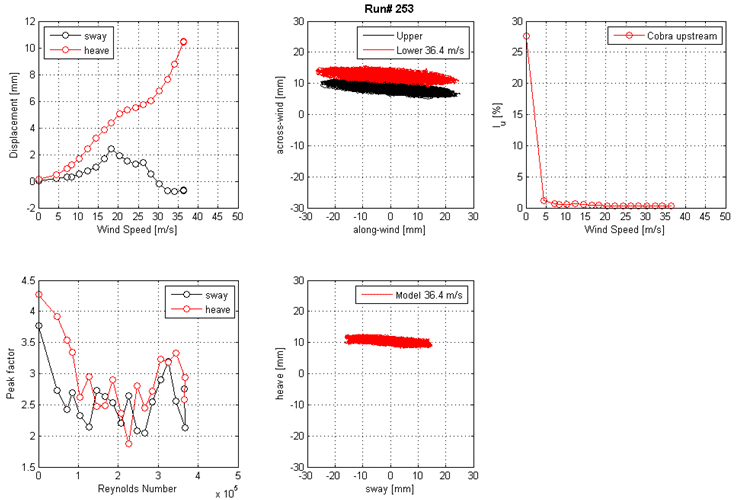 |
| Figure 177. Graph. Mean displacement and peak factor from the laser, motion path at one wind speed, and intensity of turbulence measured at the entrance of the test section for run 253. |
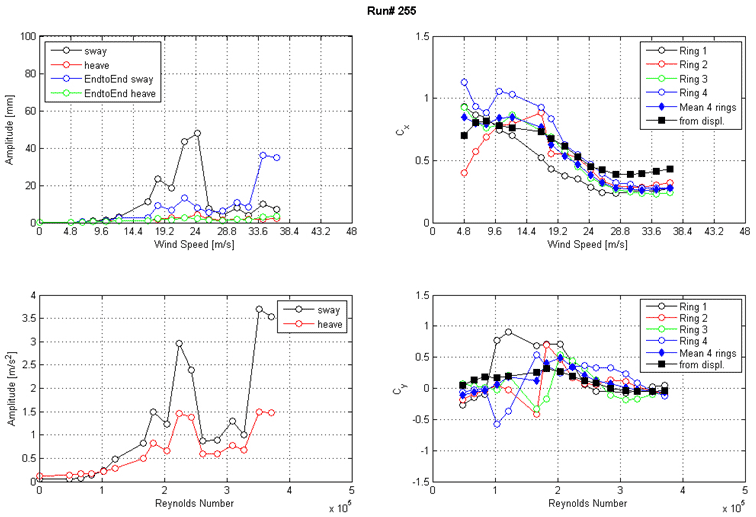 |
| Figure 178. Graph. Response of the cable as a function of wind speed or Reynolds number as measured by the lasers, accelerometers, and surface pressures for run 255. |
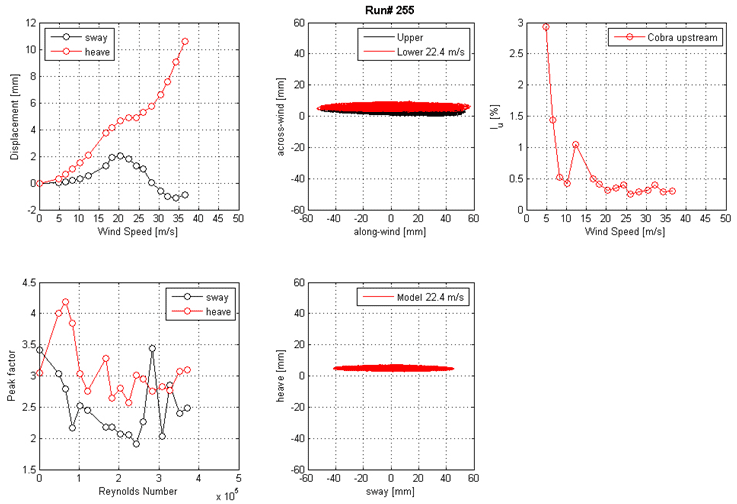 |
| Figure 179. Graph. Mean displacement and peak factor from the laser, motion path at one wind speed, and intensity of turbulence measured at the entrance of the test section for run 255. |
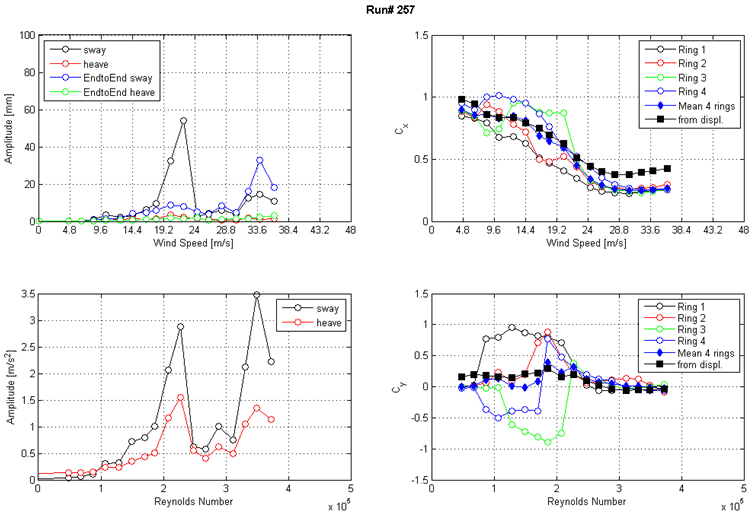 |
| Figure 180. Graph. Response of the cable as a function of wind speed or Reynolds number as measured by the lasers, accelerometers, and surface pressures for run. 257. |
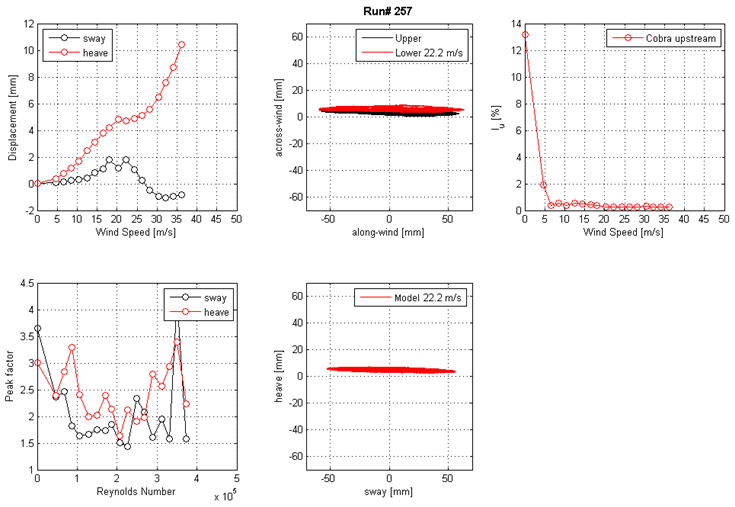 |
| Figure 181. Graph. Mean displacement and peak factor from the laser, motion path at one wind speed, and intensity of turbulence measured at the entrance of the test section for run 257. |
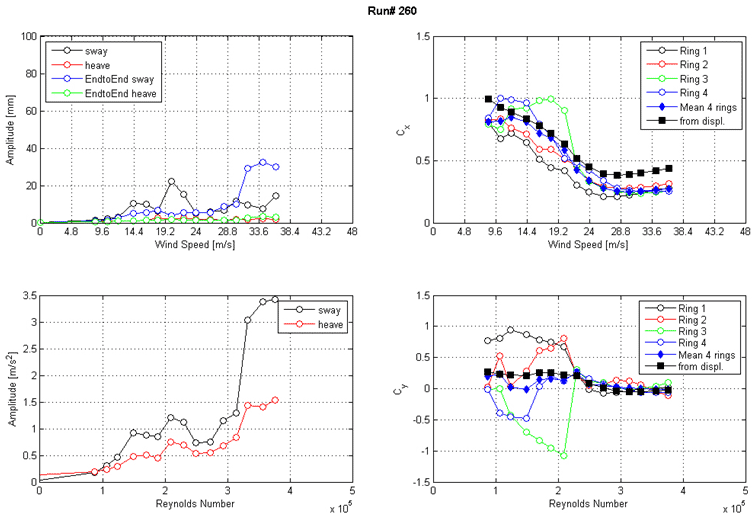 |
| Figure 182. Graph. Response of the cable as a function of wind speed or Reynolds number as measured by the lasers, accelerometers, and surface pressures for run 260. |
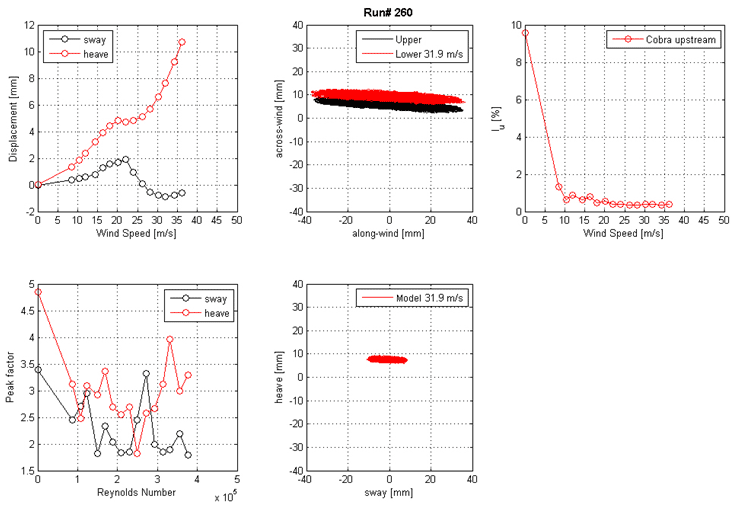 |
| Figure 183. Graph. Mean displacement and peak factor from the laser, motion path at one wind speed, and intensity of turbulence measured at the entrance of the test section for run 260. |
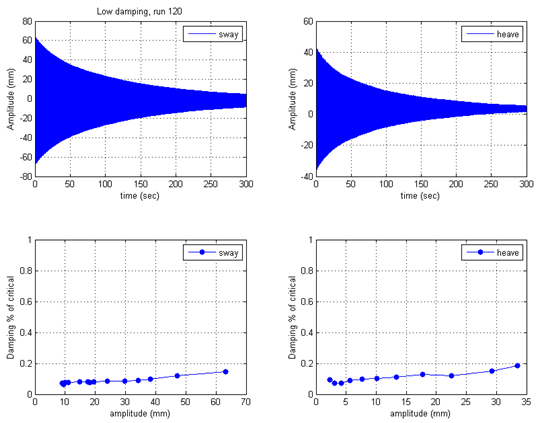 |
| Figure 184. Damping traces and level for the sway and heave modes for the low damping level case. |
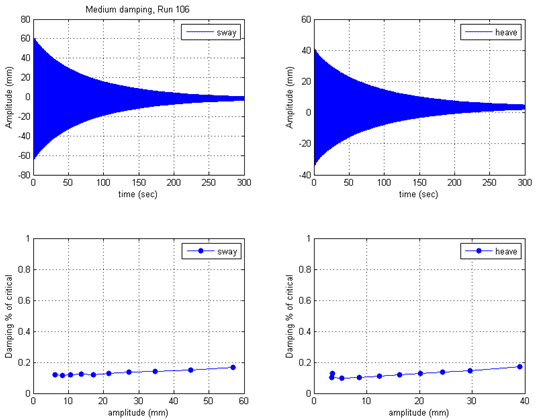 |
| Figure 185. Damping traces and level for the sway and heave modes for the medium damping case. |
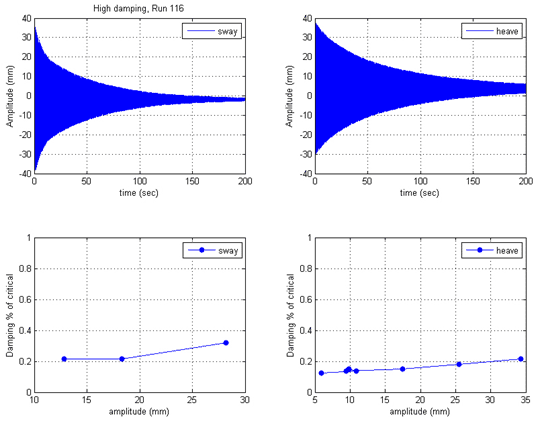 |
| Figure 186. Damping traces and level for the sway and heave modes for the high damping level case. |